“To build a city where it is impossible to build a city is madness in itself, but to build there one of the most elegant and grandest of cities is the madness of genius.” ~ Alexander Herzen
I’ve traveled to Venice three times, every time by train, and I love the moment the land gives way to blue-green water, and in the distance, you catch glimpses of the floating city.
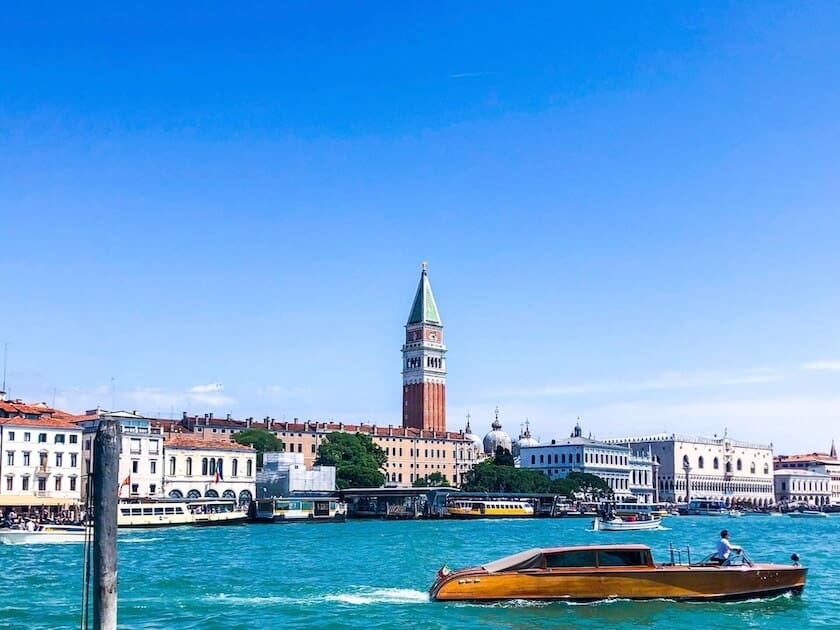
Once you exit the train station, Venice greets you like a vintage postcard. There are rows of houses and shops lining the canals while colorful gondolas and polished water taxis bob along in the water.
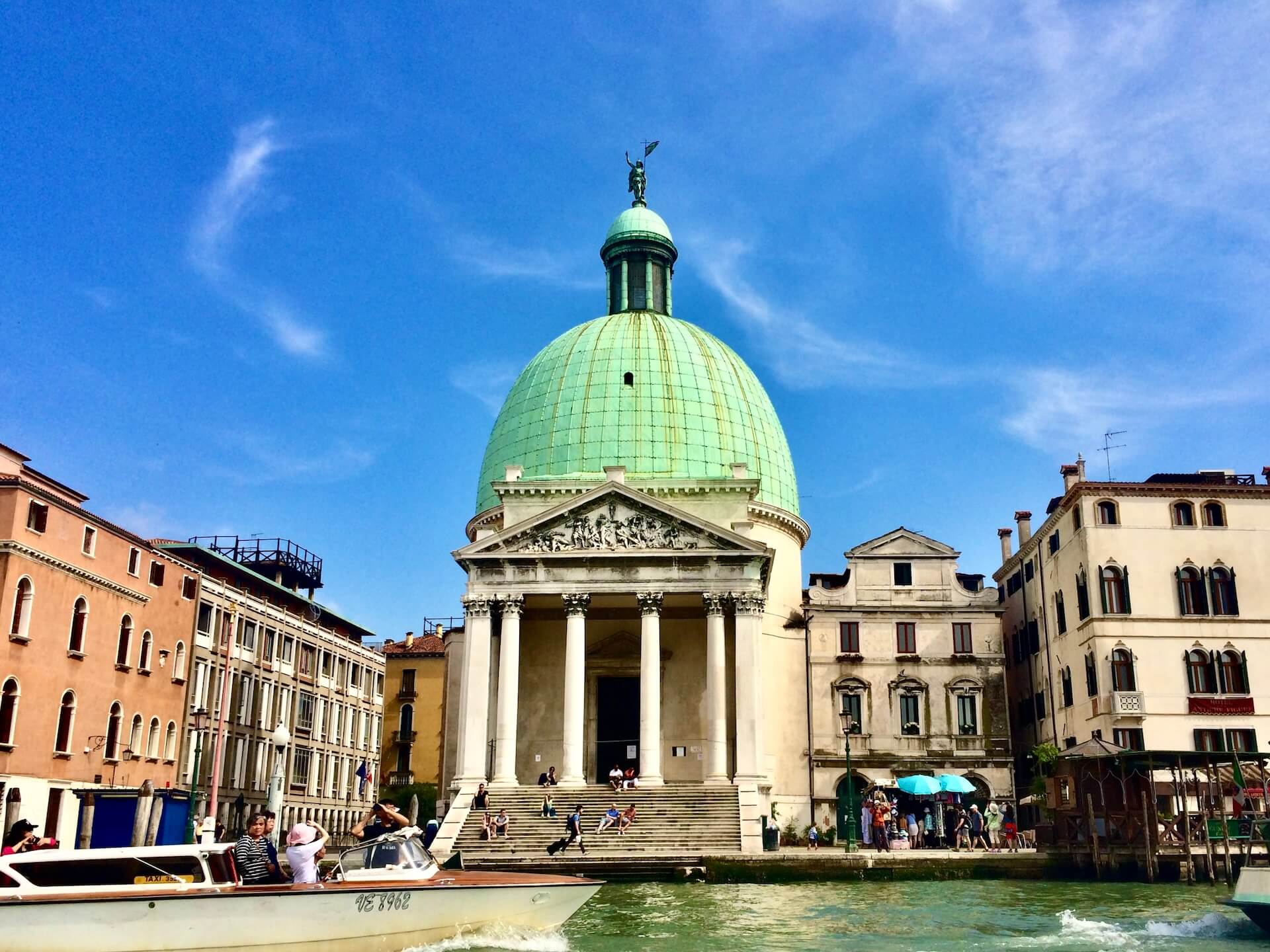
While Venice is best known for its canals, gondola rides, and Byzantine-Venetian Gothic architecture, this ancient city has so much more to offer. With so much to do in Venice, it’s no wonder this Italian city has been a cultural and tourist draw since medieval times.
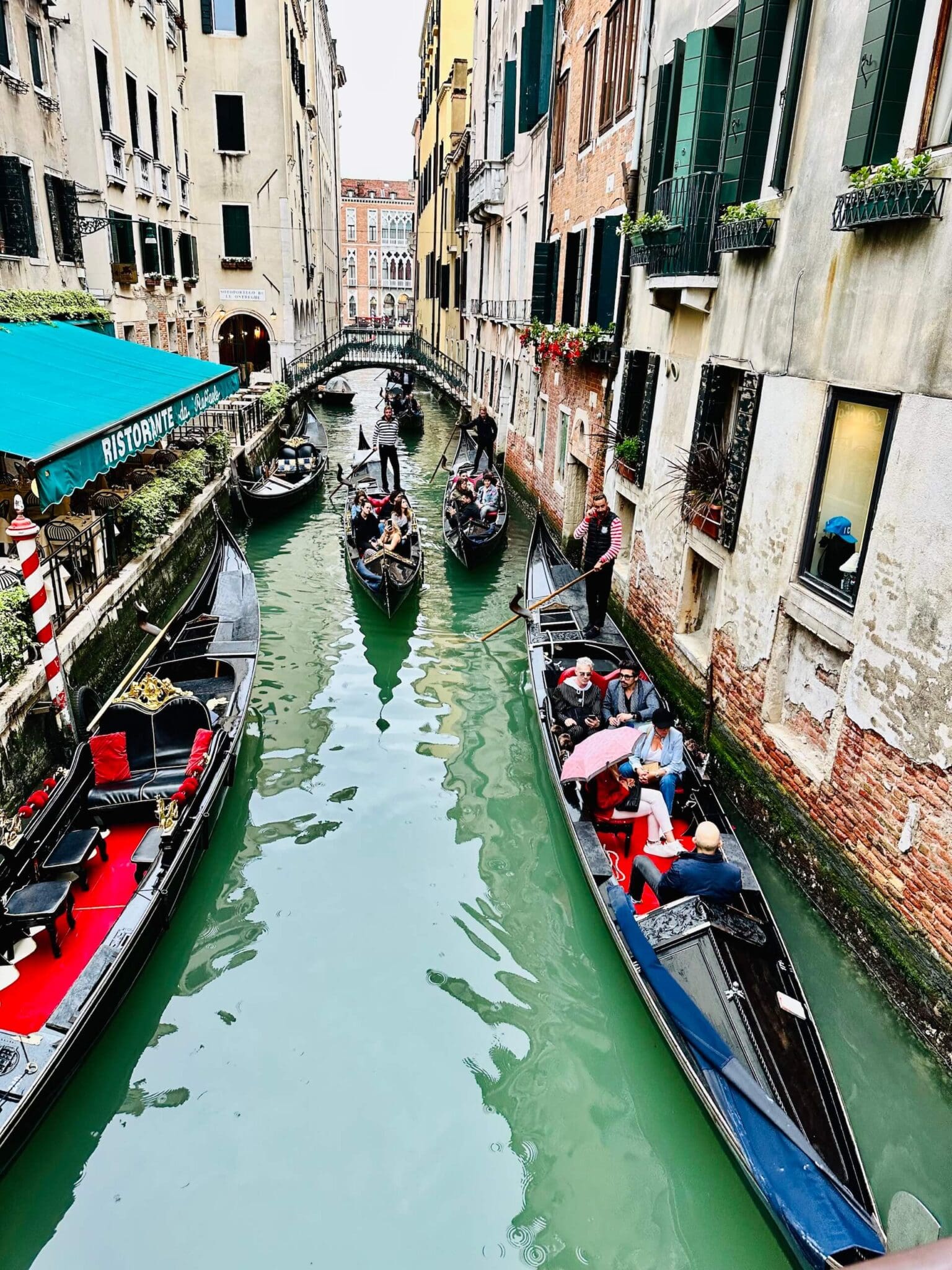
Although like most iconic cities, the main attractions can get a little crowded with tourists, it is always worth going to Venice Italy.
You need a minimum of 2 days in Venice to really see and experience the city, although 3 to 4 days is a more ideal time limit, especially if this is your first visit to Venice.
The key to making the most of your time here is planning ahead and booking your Venice tours in advance. Waiting until the last minute will not serve you well in this popular tourist city, so book everything as far in advance as you can, including hotels.
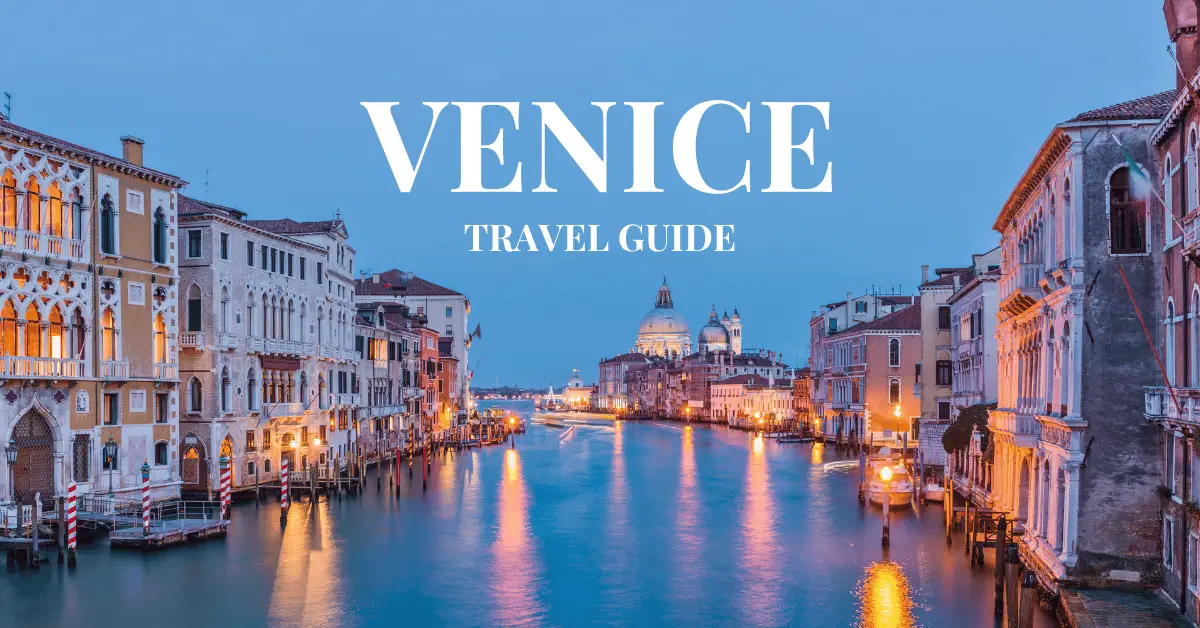
Table of Contents
Top 9 Things To Do In Venice (That’s Not a Gondola Ride)
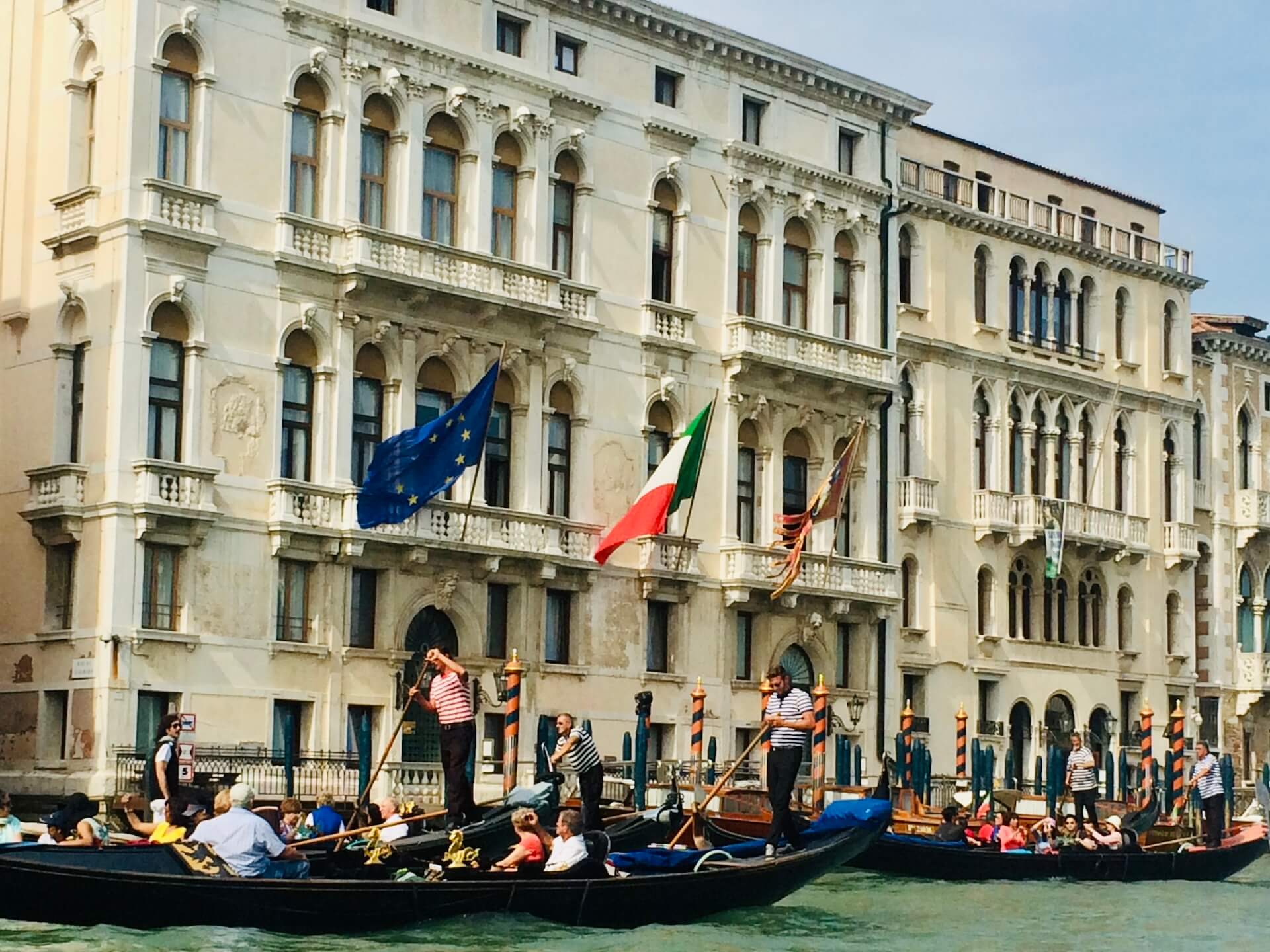
1. Visit Piazza San Marco (St. Mark’s Square)
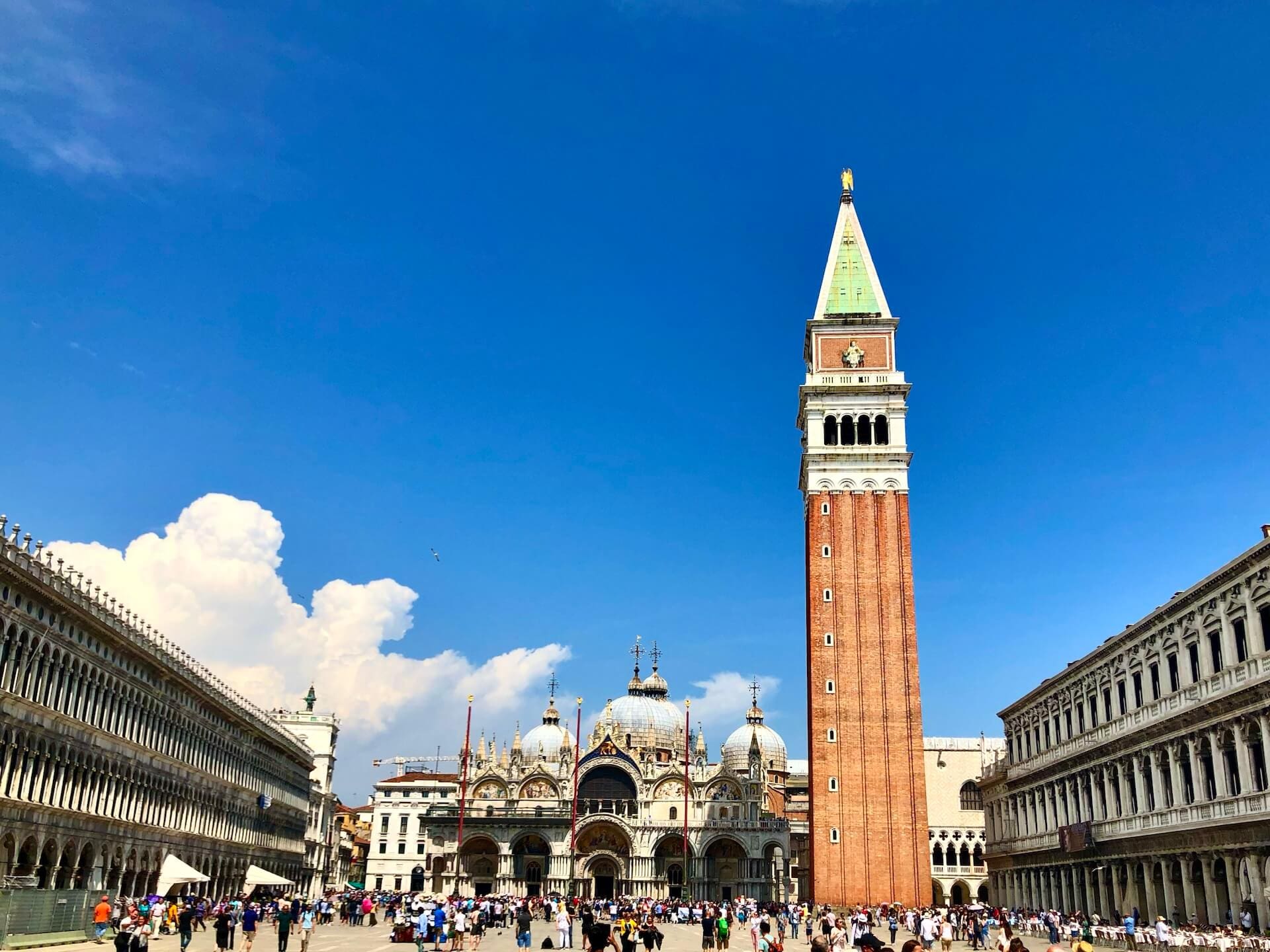
The first place you should visit in Venice is Piazza San Marco, or St Mark’s Square. This large piazza is the undeniable pulsing hub of Venice. People and pigeons flock to this vast, arcaded square.
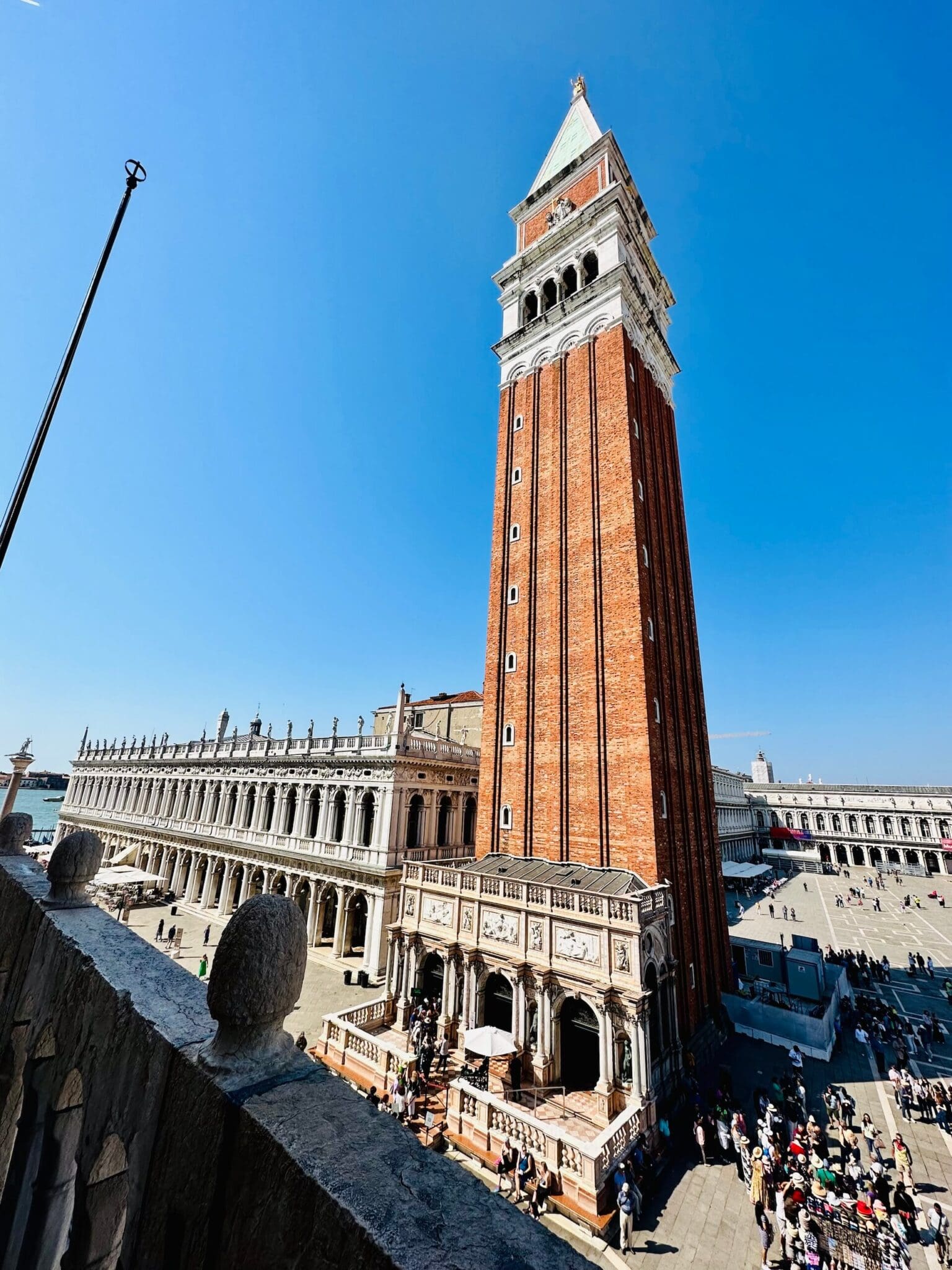
Lining either side of St Mark’s Square are various luxury shops and large cafes with grand pianos centrally positioned amongst the outdoor tables, filling the breezy air with classical music.
At the cafes, you can order light snacks, or an aperitivo, sandwiches, desserts, and more, but the prices (and expected tip) are quite high.
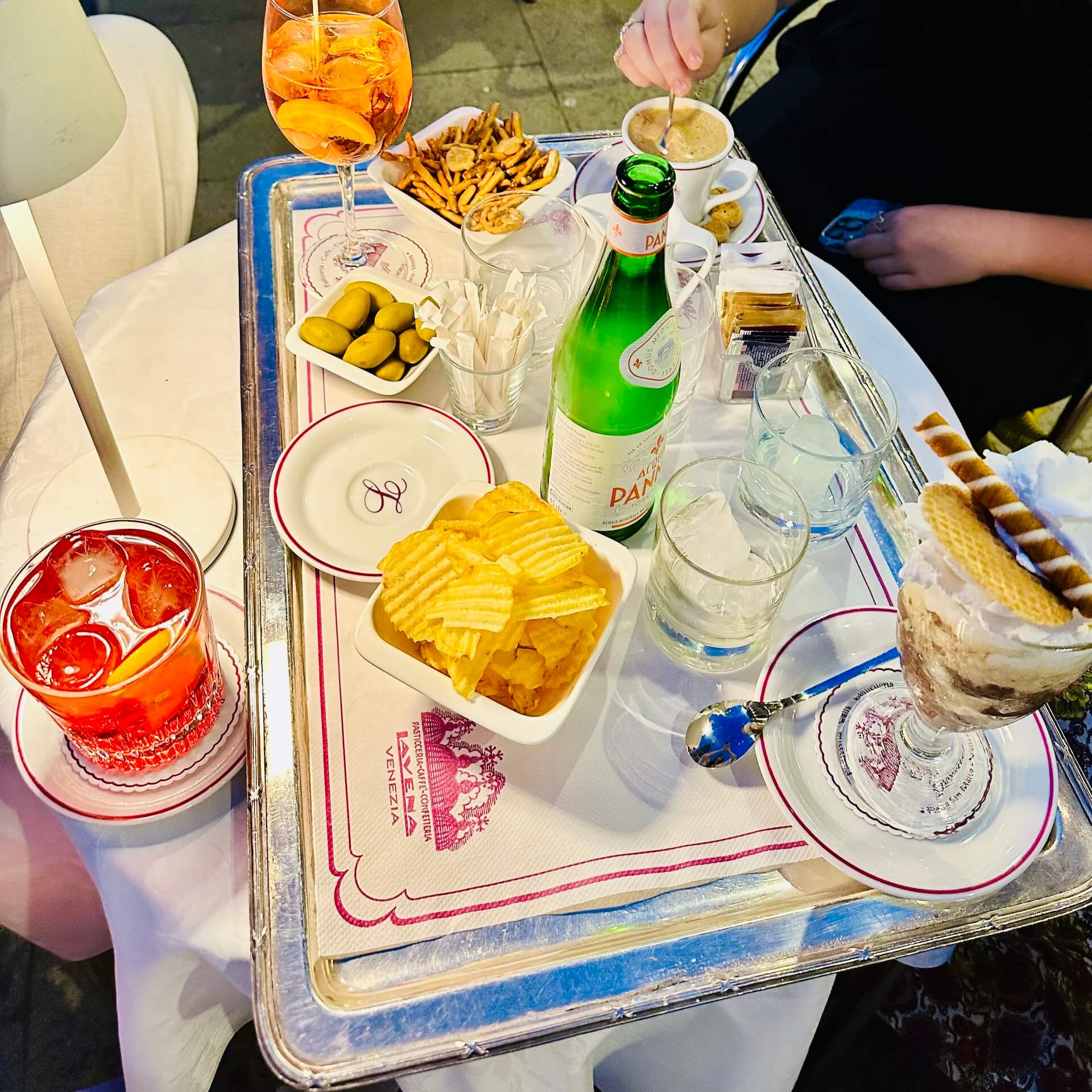
On my last visit to Venice, I enjoyed an aperitivo and dessert at the Gran Caffe Lavena, situated at the foot of the clock tower, in front of the Basilica.
Opened in 1750, the Gran Caffé Lavena has been one of Venice’s most renowned coffee boutiques. While I really enjoyed this experience, sitting and watching dusk fall over the square with the sounds of the orchestra filling the air, I’m not sure I feel the need to do it again.
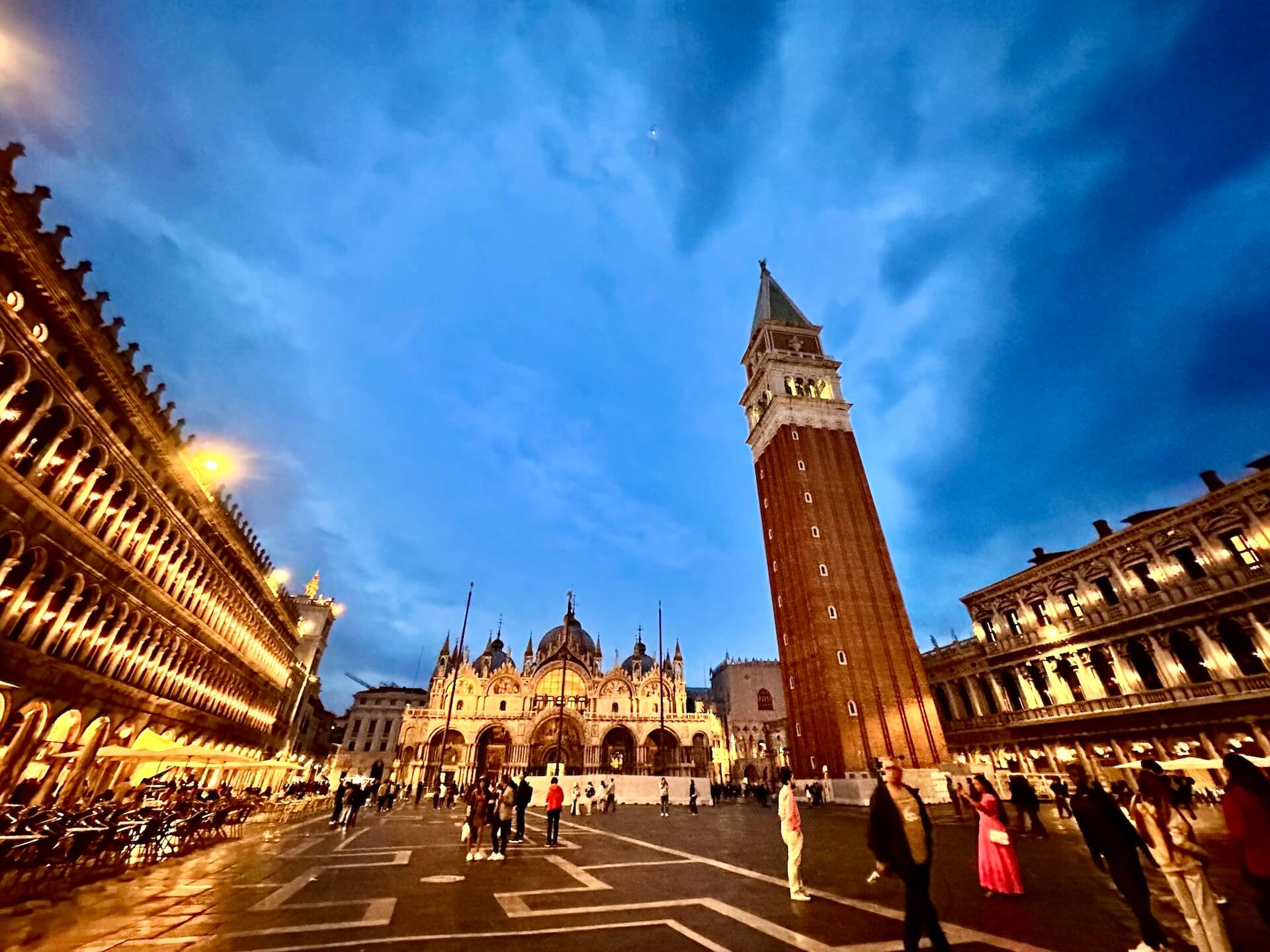
2. Tour St Mark’s Basilica
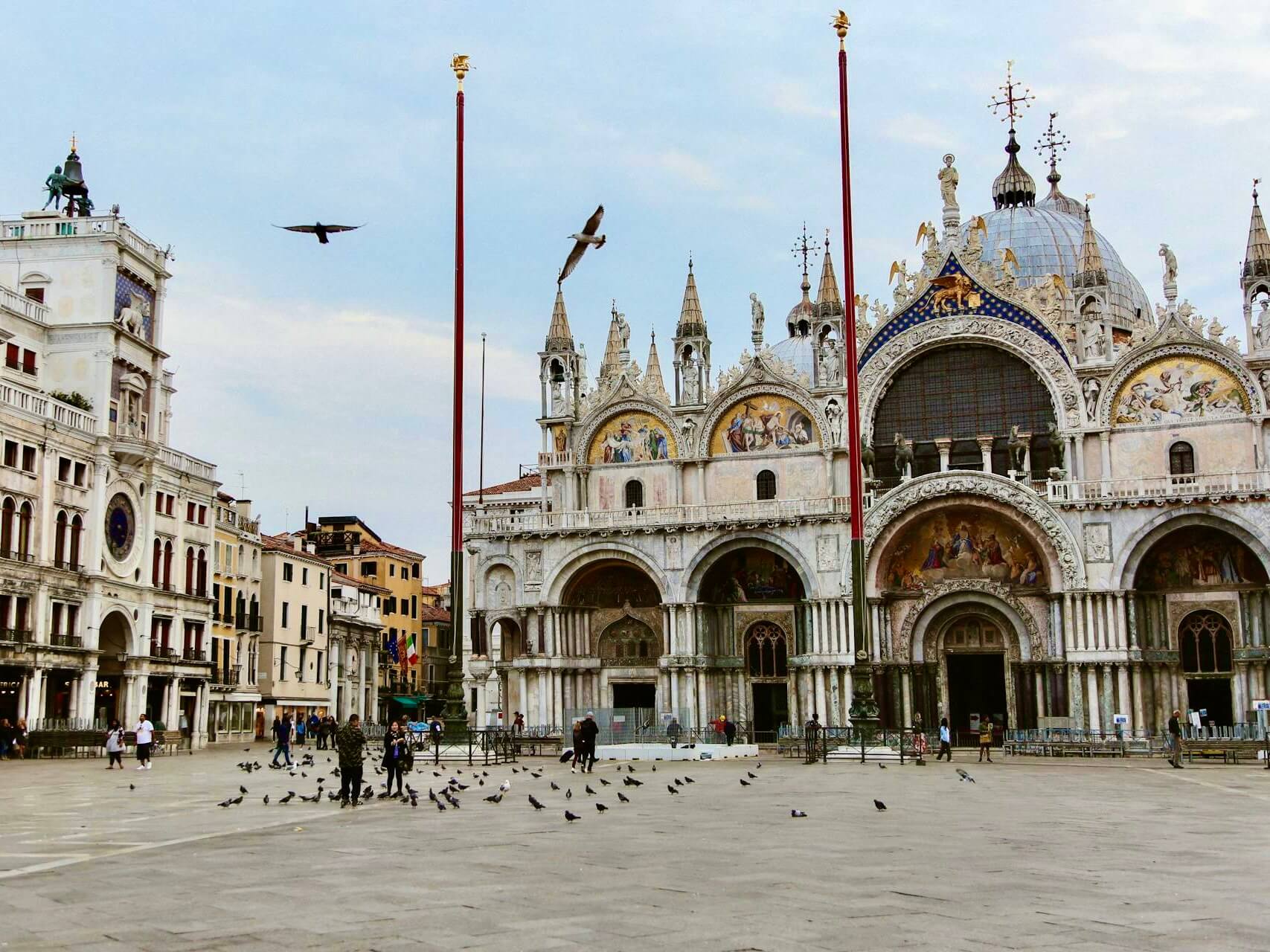
If you think St Mark’s Basilica is amazing on the outside, wait until you see the inside. Construction began on the Byzantine-style Basilica in 829 and was completed around 1071. St Mark, the patron saint of Venice Italy whose symbol is the winged lion, is said to be buried here.
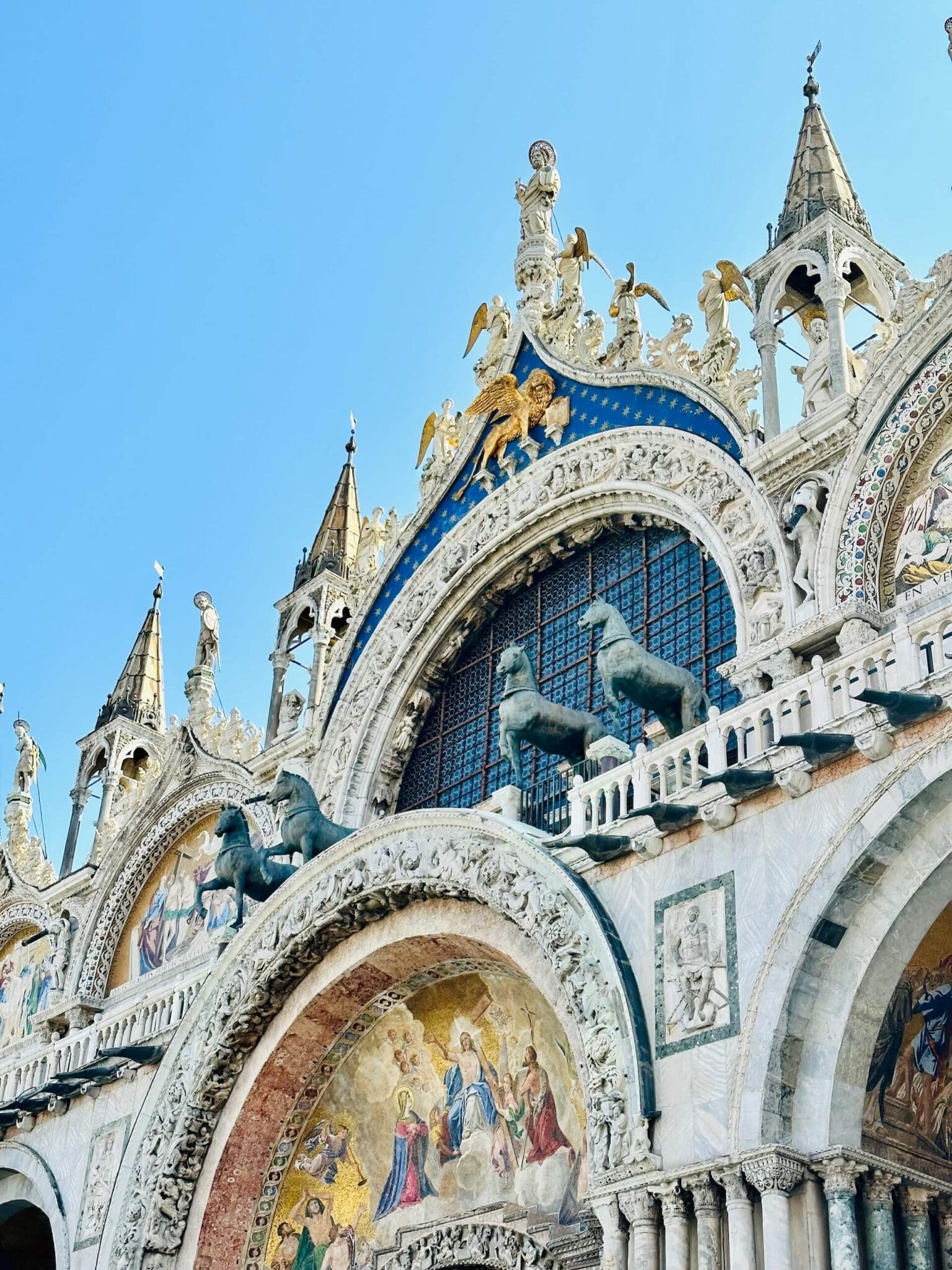
It seems like there is a perpetual line of people waiting to tour this Basilica, so if you want to visit, reserve ahead.
*Note: Due to the religious nature of the Basilica, all individuals (regardless of gender) must cover their shoulders and knees. If you’re wearing a sleeveless top or dress, a shawl is acceptable to cover your shoulders while inside. Backpacks are also not allowed.
If you book a specialty tour, you’ll meet your guide ahead of time at a designated area of St Mark’s Square. From there, you’ll be given your ticket and audio headset and will enter the line for entry.
One of the most impressive aspects of St Mark’s Basilica is the gold inlay of the ceiling, gleaming down and casting a pale sheen over the columns and the mosaic floor.
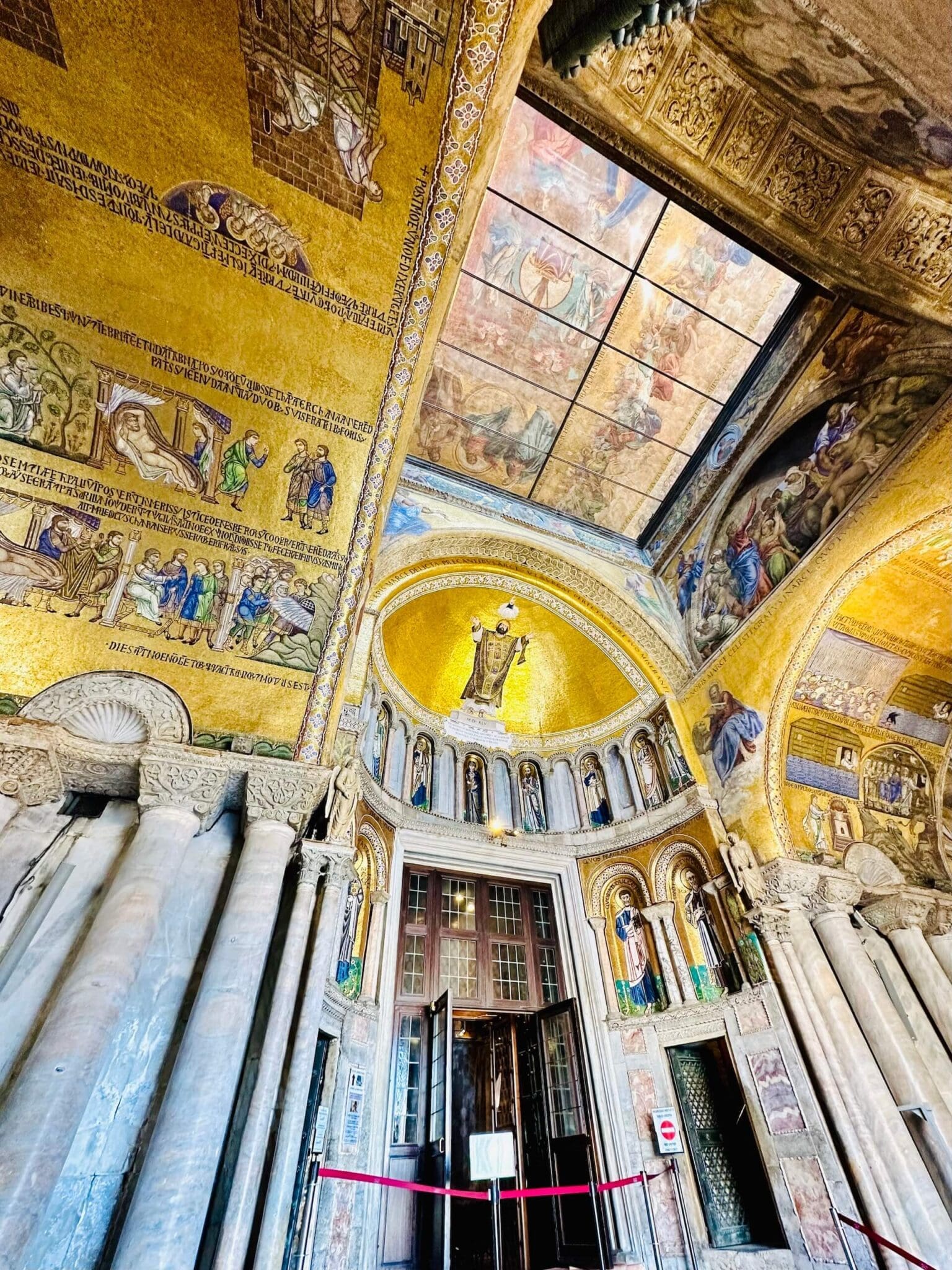
If you are physically able, I highly recommend a tour that gives you access to the private terrace. Not only do you get a more elevated view of the interior of the basilica, but the terrace views are incredible as you overlook the square below, the campanile (bell tower), the Doge’s palace to the left, and views of the Grand Lagoon beyond.
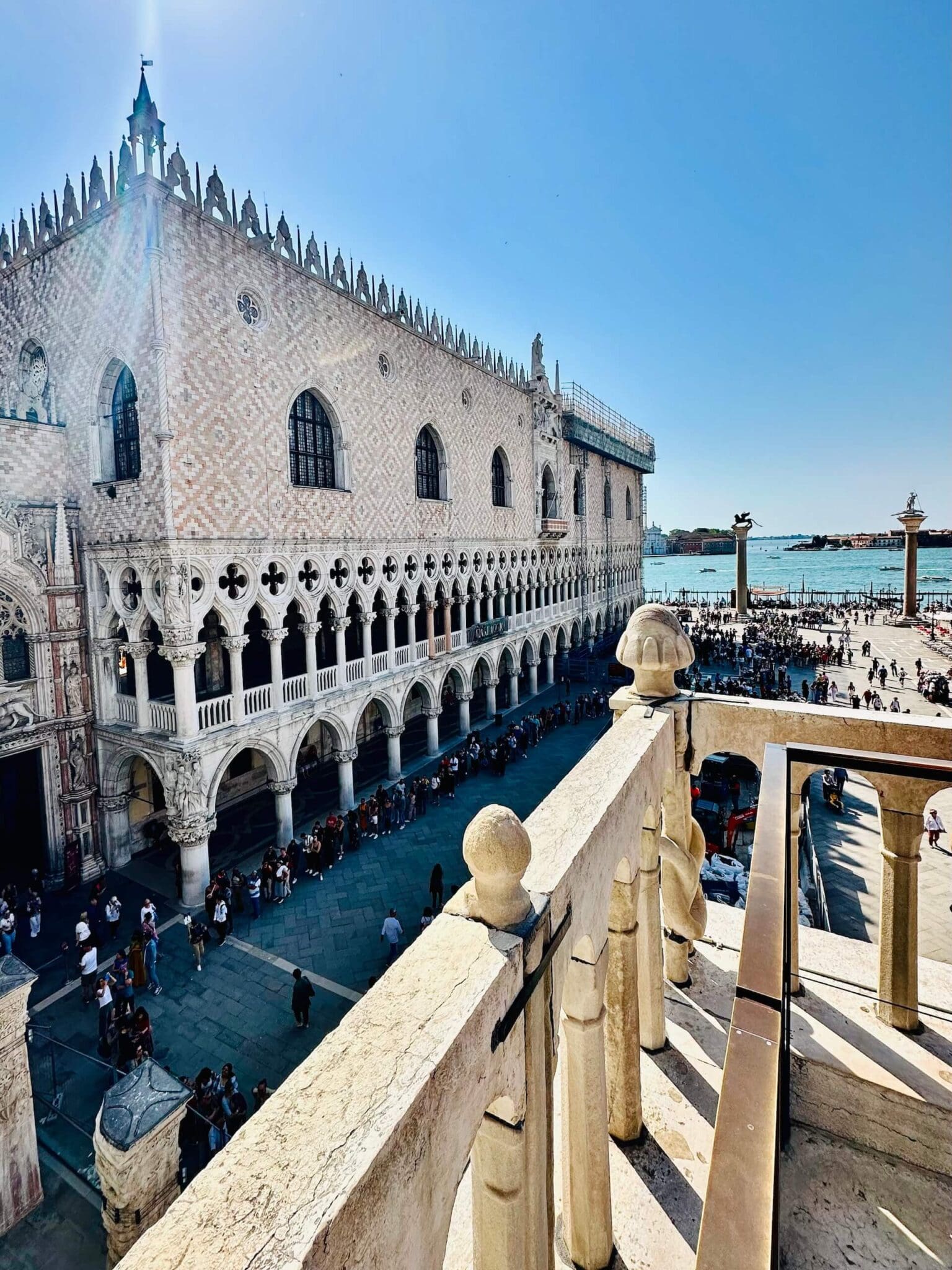
The tour I booked also includes a guided tour of the Doge’s Palace afterward, which I recommend as well. If you’re interested in booking the same tour or something similar, click the button below.
3. Tour The Doge’s Palace
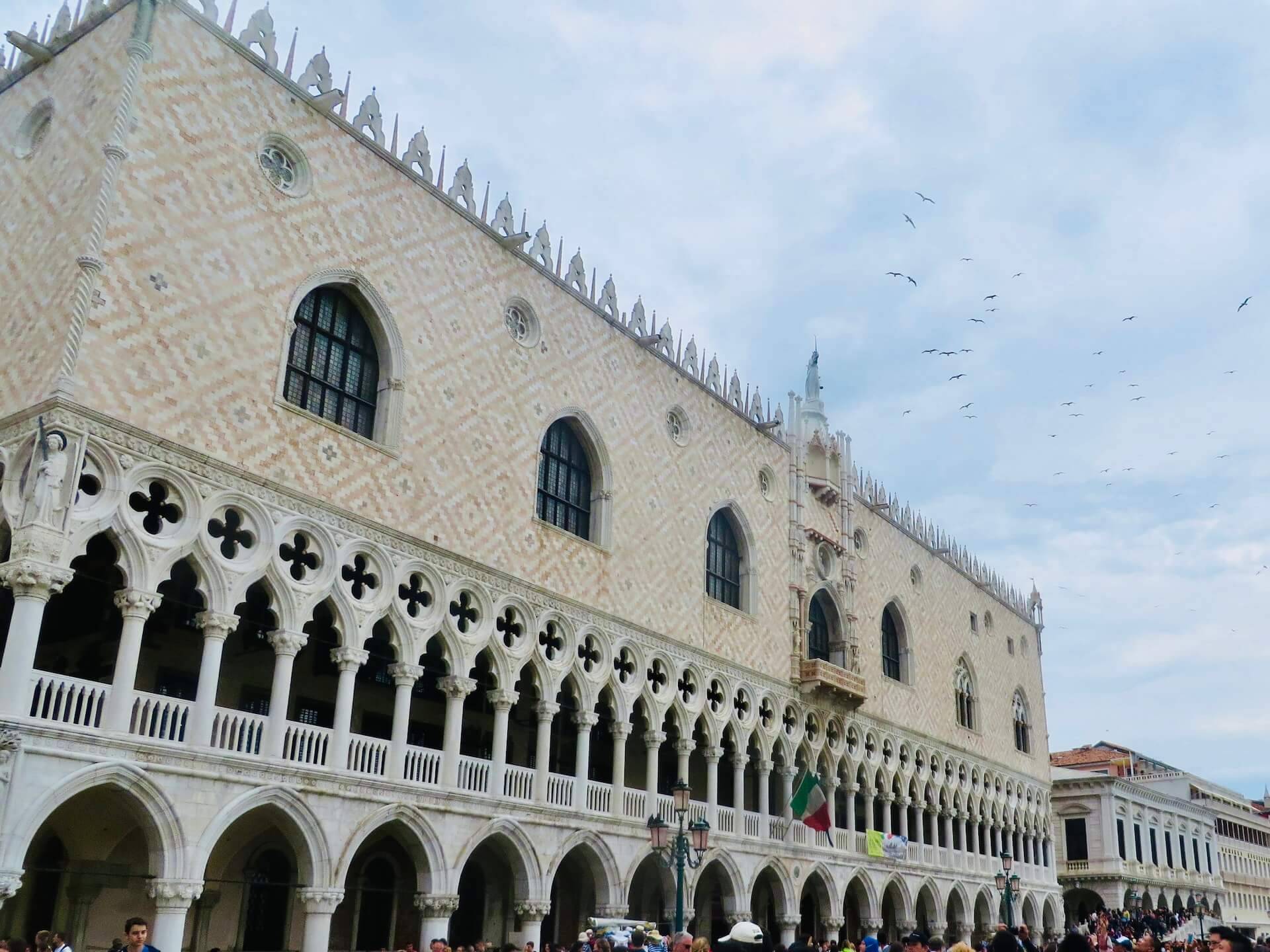
Touring the Doge’s Palace can be exhausting since there is so much to see and learn here, but taking a guided, “skip the line” tour is time well spent, especially if you enjoy history and/or art and don’t want to waste your precious time in Venice waiting in line.
The tour begins in the courtyard as you slowly climb your way to the large offices and apartments while learning about the gritty and sometimes corrupt politics of Venice during Medieval times and the Renaissance.
One of my favorite moments was learning about the Bocche di Leone (lions’ mouths) or “mouths of truth” where citizens of Venice could voice their concerns or accuse someone of a crime anonymously by slipping a note through the mouth of the carved faces. The one still intact inside the Doge’s Palace dates back to 1618.
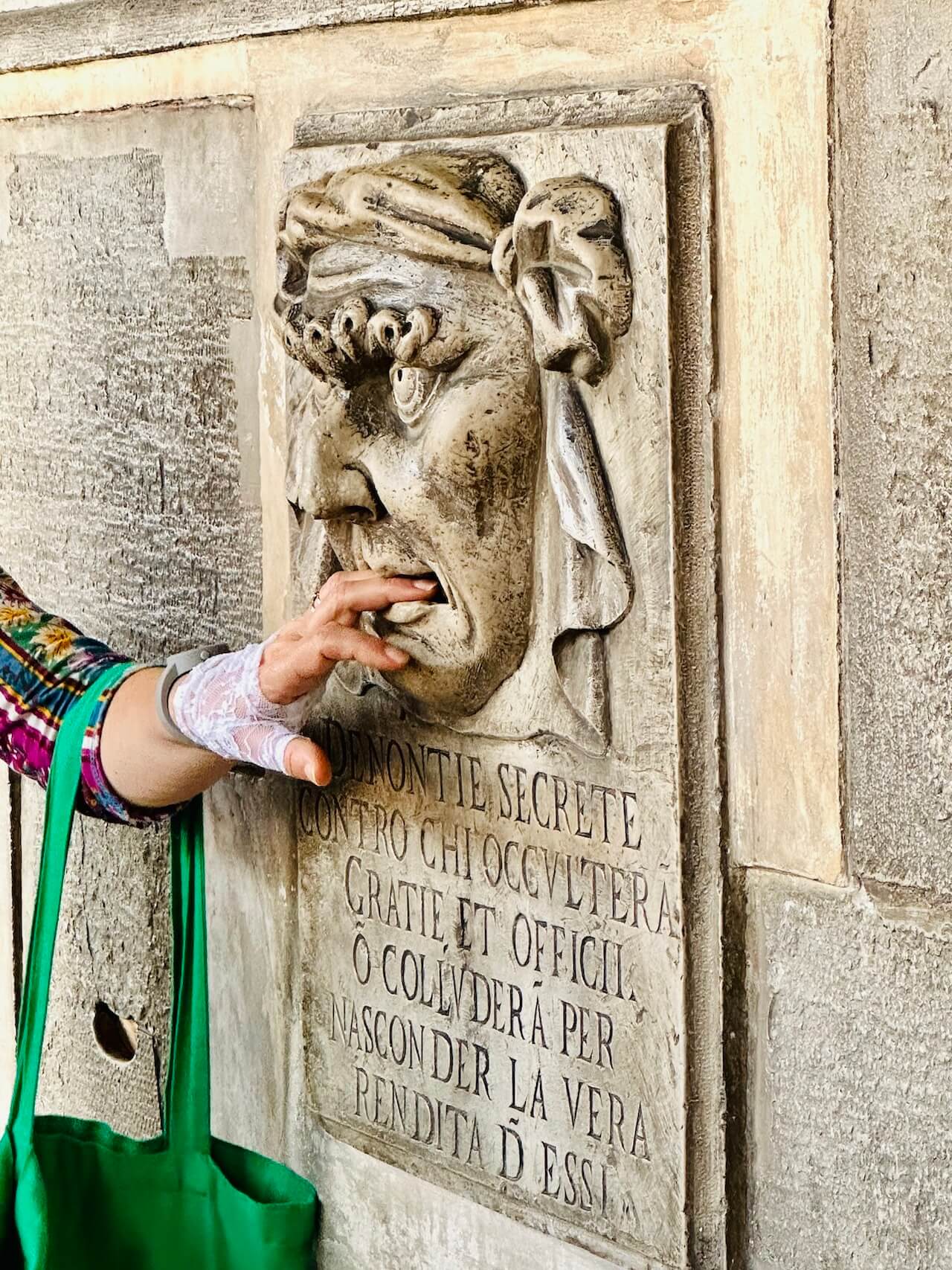
Depending on your tour, you may also be able to tour the rooms where the legendary Giacomo Casanova was imprisoned and see the chair where he kept the secret tunneling equipment that he used to escape.
Finally, you’ll be able to walk across the famous Bridge of Sighs (named because it was the path prisoners had to walk on the way to their jail cells).
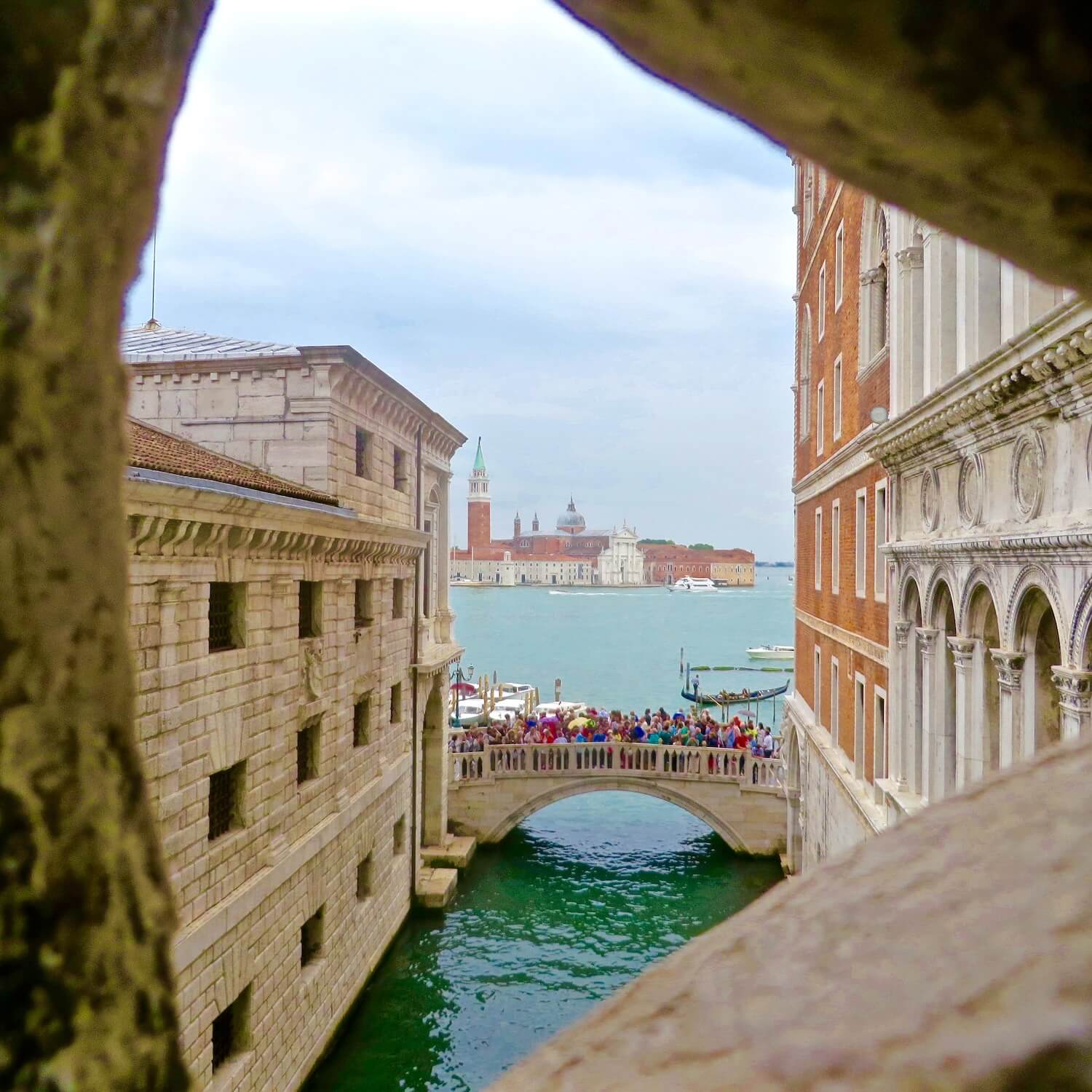
Inside the Bridge of Sighs, you can peer through the crisscrosses to the horde of tourists on the bridge across, imagining what it would be like if this was your last glimpse of the outside world.
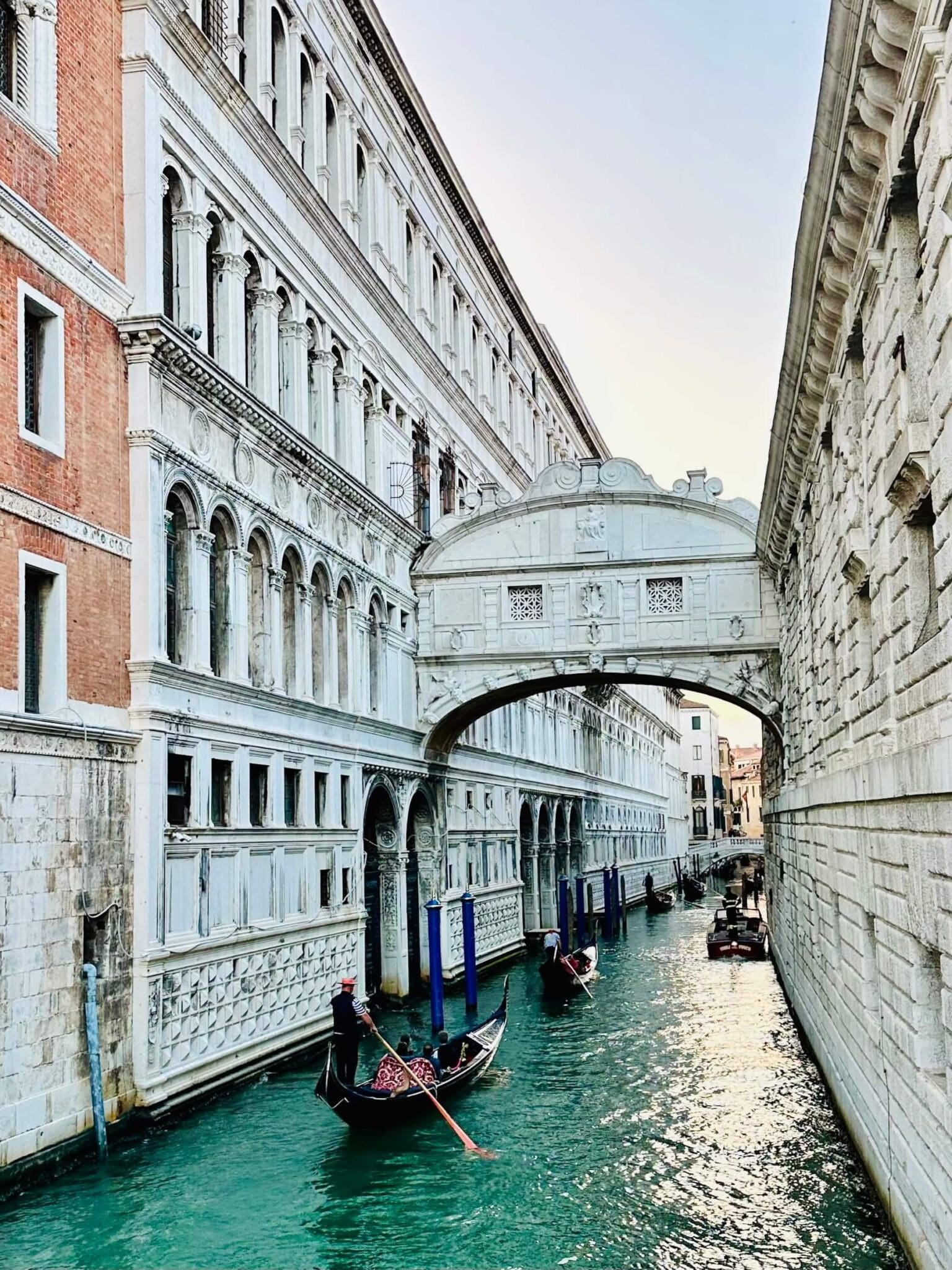
The Doge’s (Duke’s) Palace, with its soaring ceilings and great halls, is overflowing with art and history. The tour ends in the gift shop (where else?).
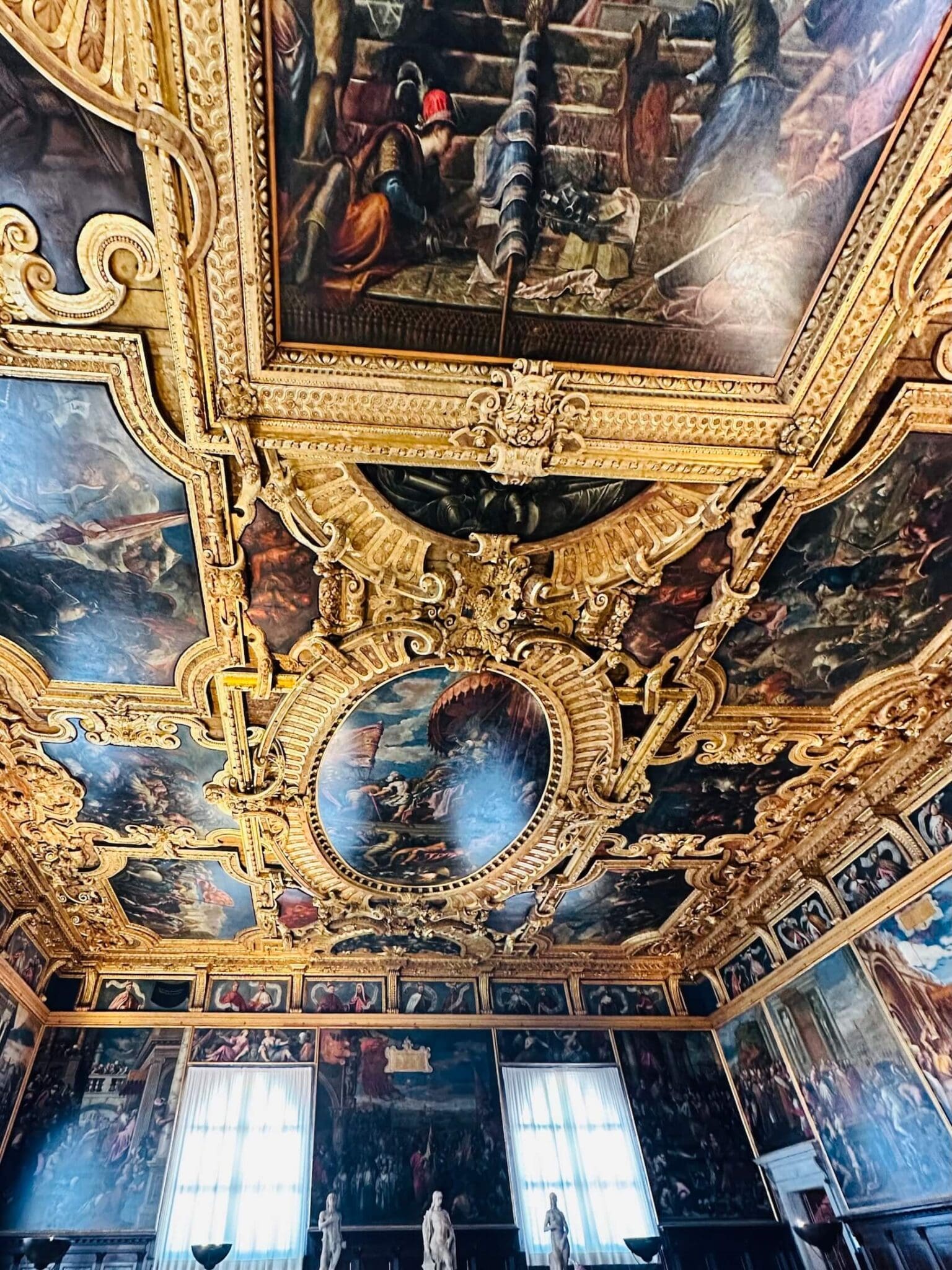
*Note: If you need a bite or an espresso pick-me-up before or after touring St Mark’s Square, venture into the back streets behind the Doge’s Palace and the Basilica where there are loads of reasonably priced cafes where an espresso won’t cost you 8 euros or more.
This area is also filled with beautiful shops that offer similar items (Murano glassware and jewelry) to those in the main piazza but at a fraction of the cost.
4. Climb St. Mark’s Bell Tower
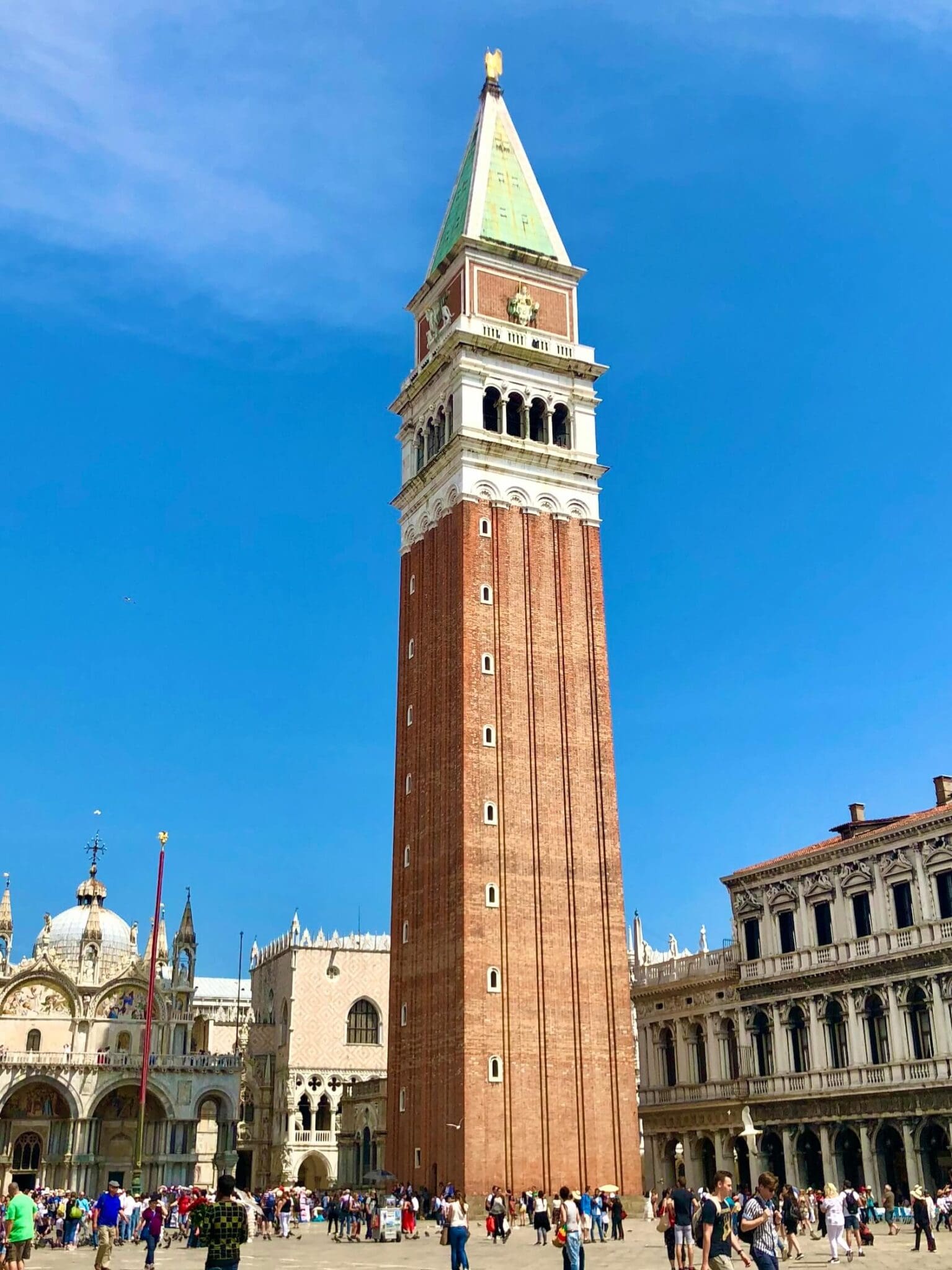
Standing like a red-brick sentinel in front of St Mark’s Basilica is the 324-foot campanile, or Bell Tower, originally built in the late 14th century.
The bell tower collapsed in 1902 but was quickly rebuilt and completed in 1912. An elevator is available inside to lift you to the open-air belfry, offering panoramic views of St Mark’s Square and beyond.
For the “Skip the Line” tickets to St Mark’s Campanile, click here.
5. Go Shopping on the Rialto Bridge
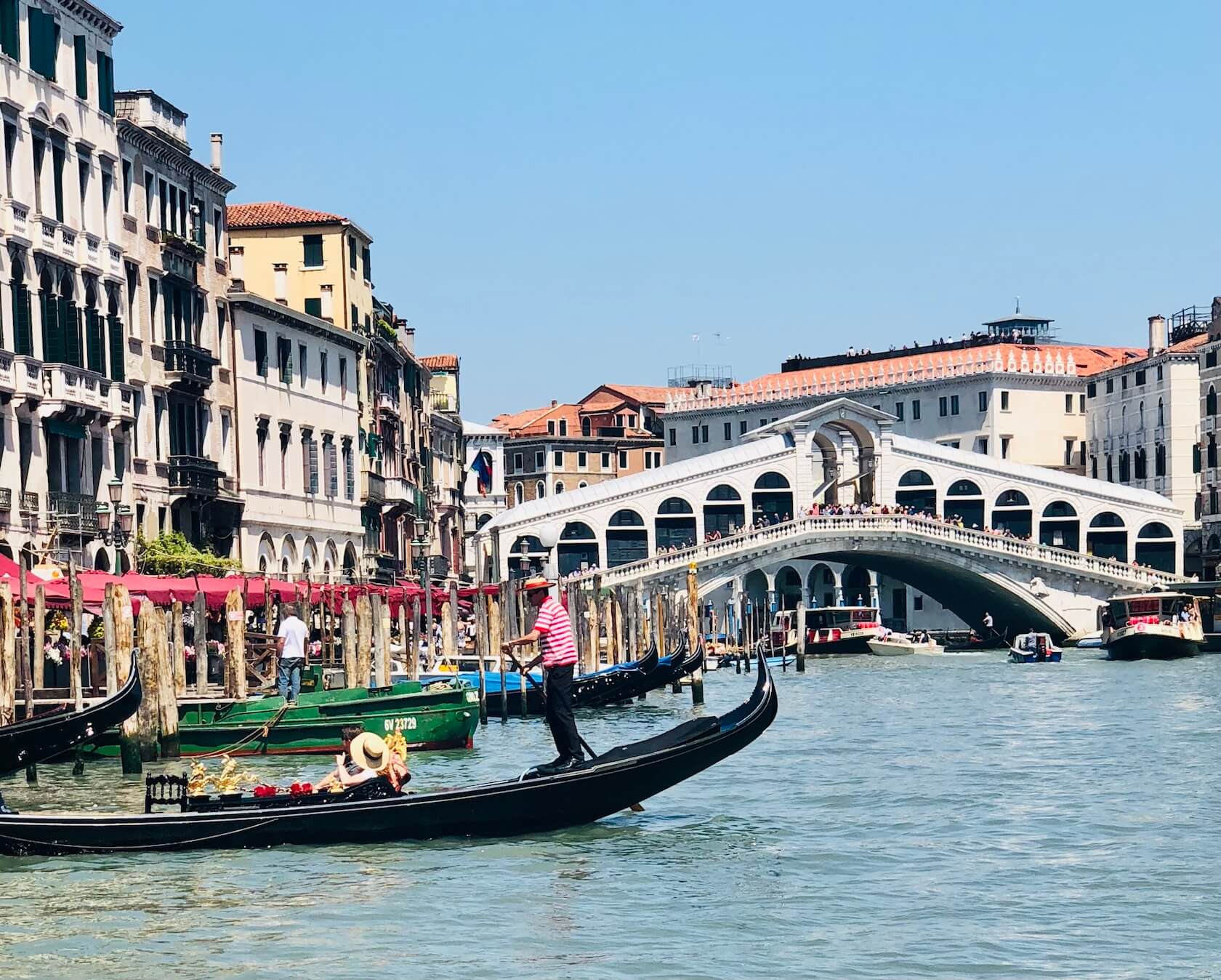
Known originally as the Rivo Alto, this early settlement eventually became known as “Rialto,” and this central bridge served to link the separate islands and canals.
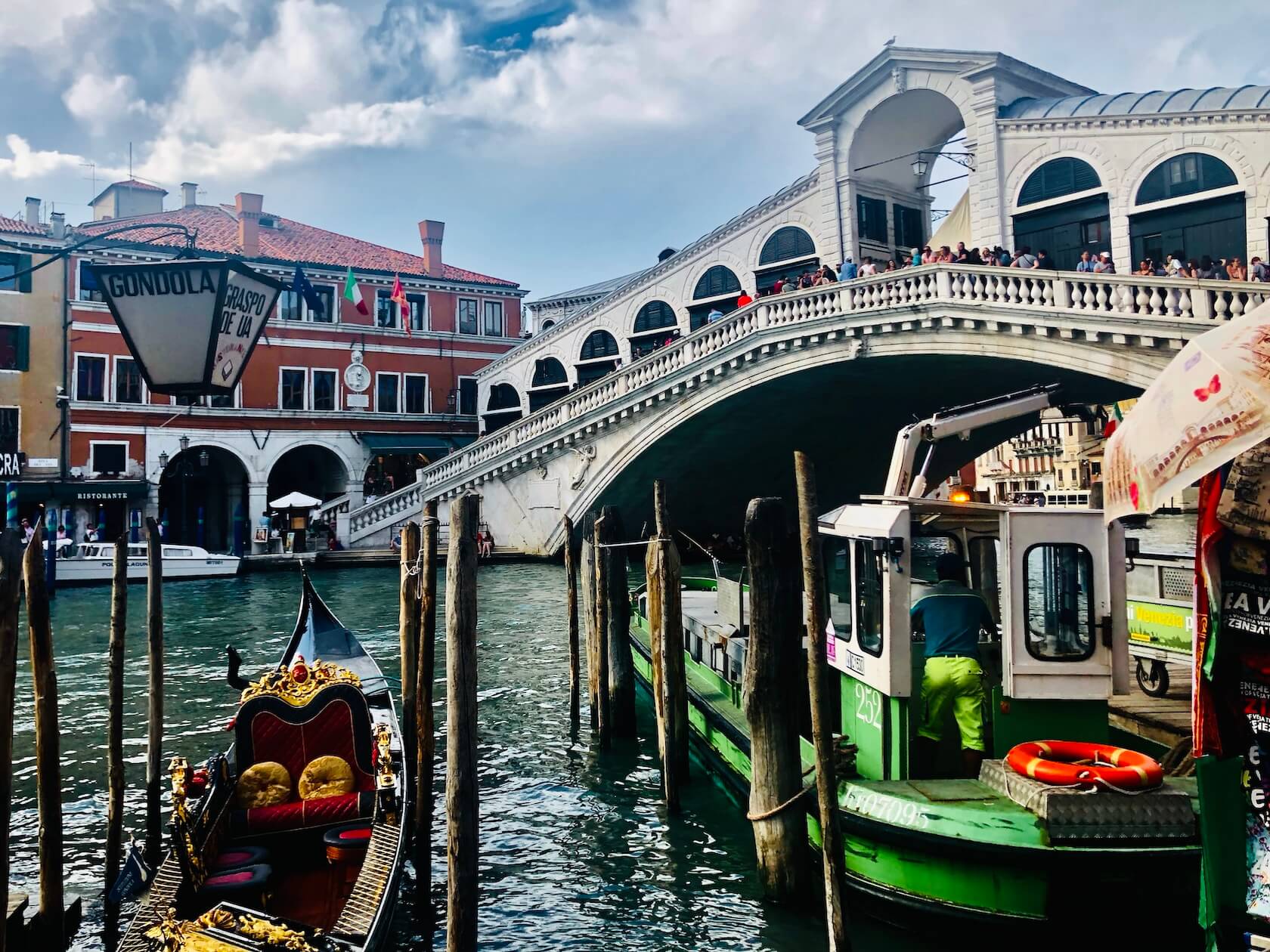
The area is filled with vendors, selling everything from leather purses to elaborate masks to fresh fish in the market. There are even establishments that offer foot treatments where you submerse your feet into a tank while fish nibble off your callouses.
It’s easy to get turned around exploring the shops of the Rialto area, and some passages lead to dead-ends where the only options are to retrace your steps or swim the canal.
But, even if you get lost, or your feet get tired, there are piazzas everywhere lined with cafes where you can collapse for a rest and a refreshing beverage.
Ultimately, if you do get lost, remember that you’re in Venice Italy so just enjoy the experience. In this day and age, you’re bound to find your way again. It’s always much harder to lose yourself.
6. Take a Boat to the Isle of Murano
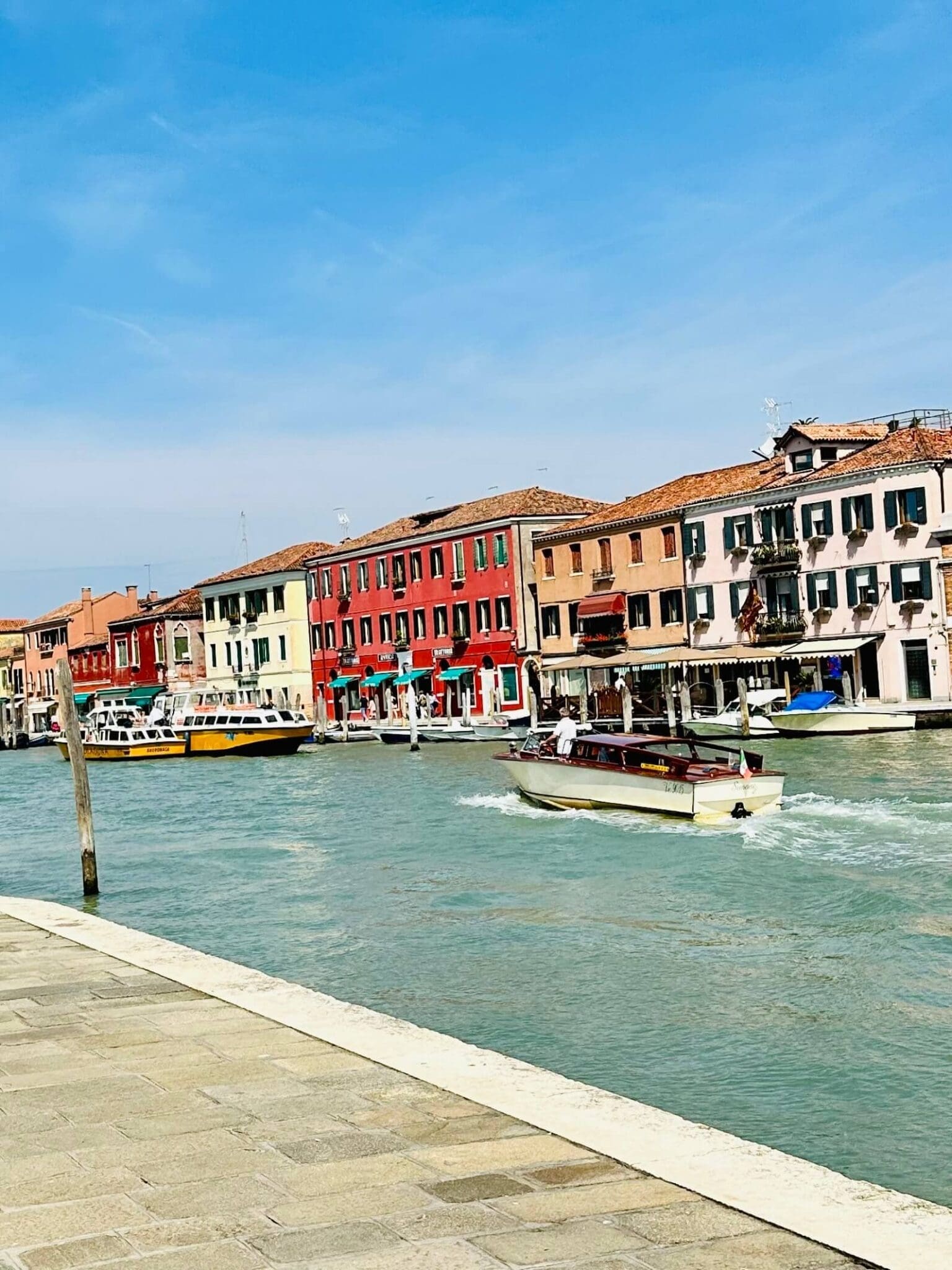
It wasn’t until my 3rd trip to Venice that I finally decided to visit the island of Murano, and I’m so glad I finally did.
Murano is most widely known for its intricate glass creations and the artisans who preserve the ancient art of glassblowing. When you visit the shops in Venice, you’ll most likely see Murano glass for sale, and many of the hotels (particularly the Danieli) are filled with Murano glass chandeliers and light fixtures.
Compared to Venice, Murano is quieter, calmer. Even though the island is a tourist hub as well, it’s much less crowded.
Even if you don’t plan to buy any Murano glass, a visit to a glass-blowing demonstration is fascinating to watch. I chose to visit the OMG Murano Glass Factory & Showroom, and I highly recommend it.
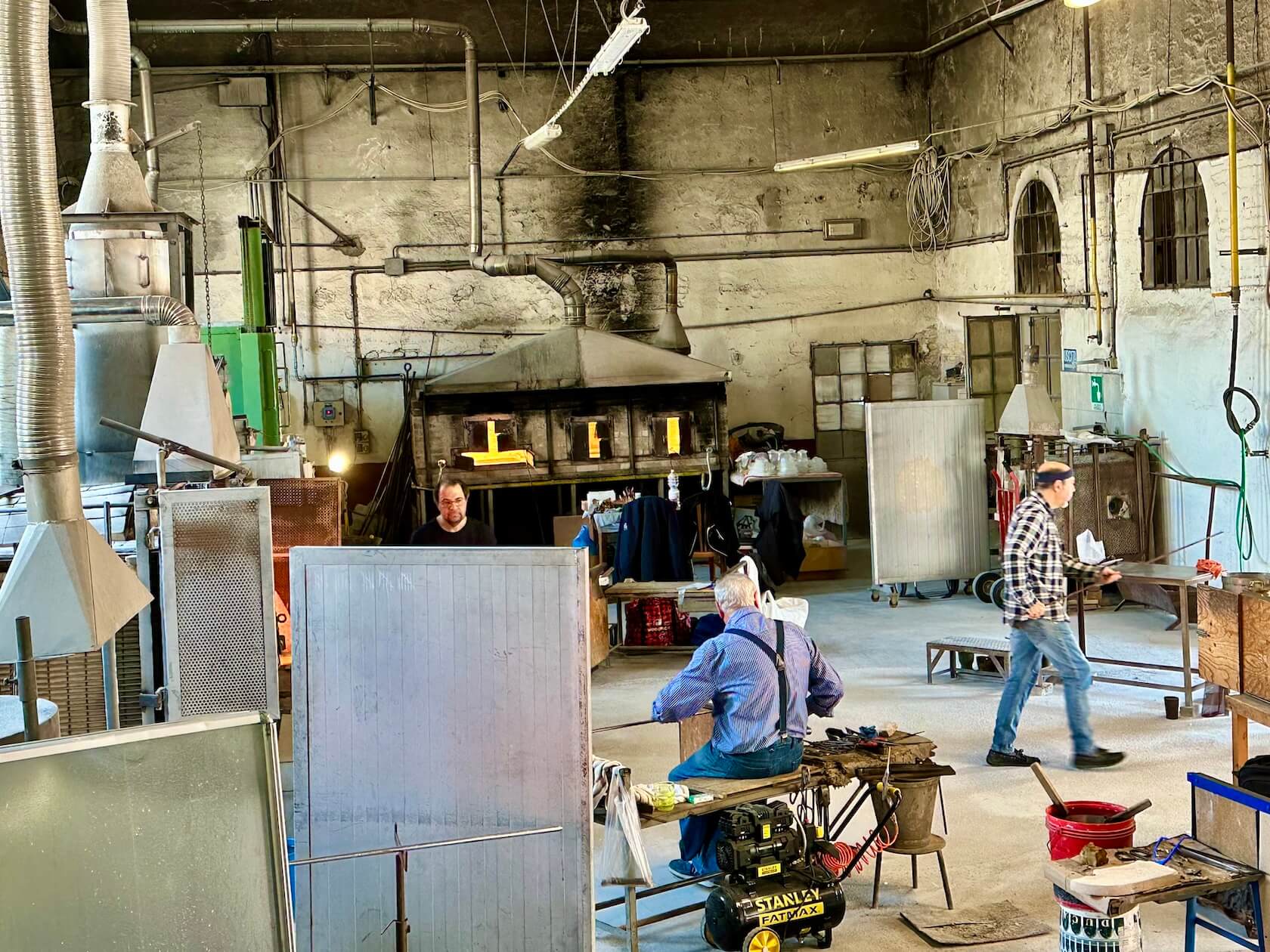
Bleachers are set up for elevated seating while viewing the demonstration, and a guide with a microphone talks you through what you are seeing.
During my visit, the chief glassblower shaped a blob of red molten glass into an elegant horse figurine. The signature horses along with a wide variety of jewelry and glassware are available for purchase inside the large factory shop which you’re able to visit after the demonstration.
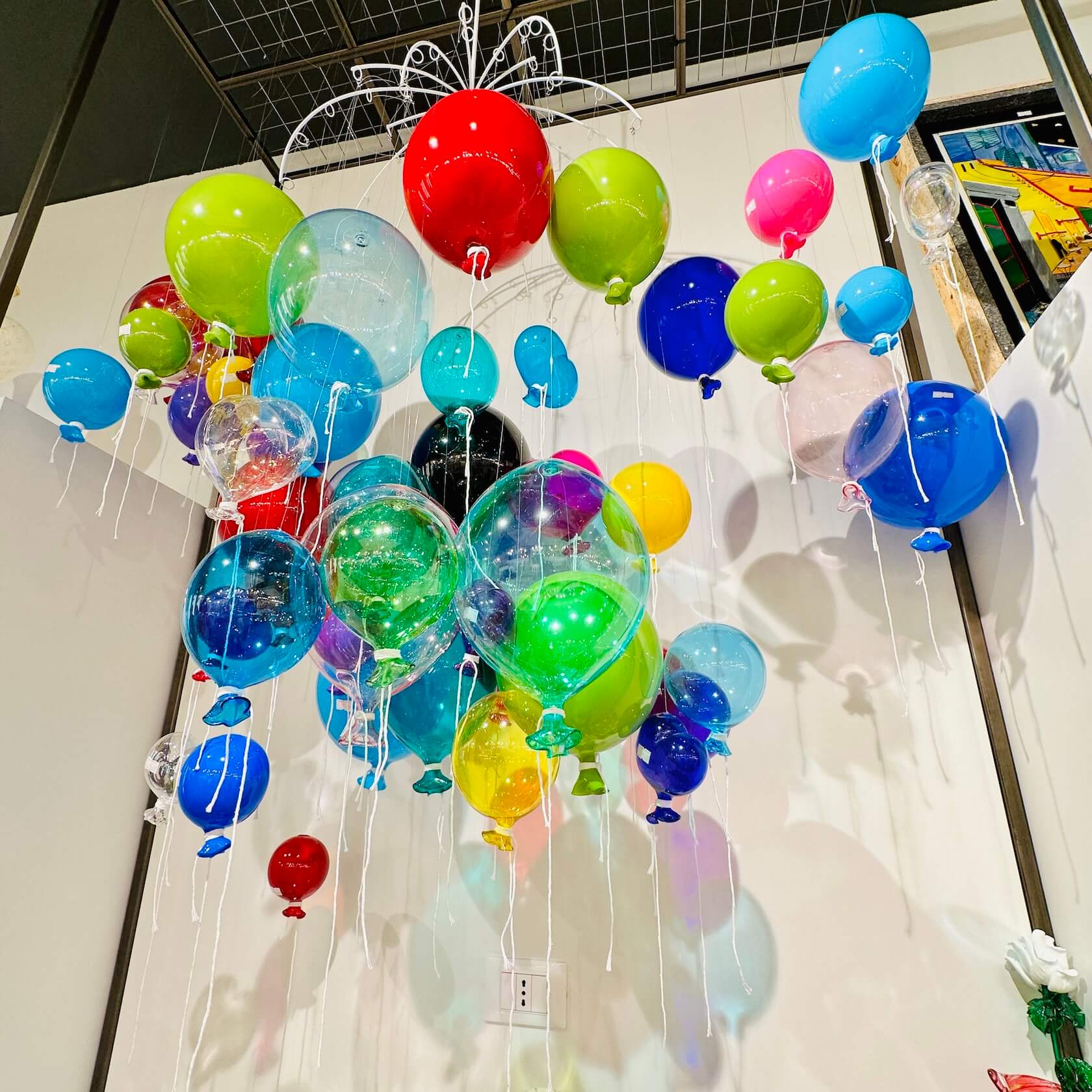
When you’re finished touring a glass factory, take some time to explore the additional shops on Murano. One of my favorite shopping areas was along the Fondamenta dei Vetrai. This stretch of street offered several affordable Murano glass jewelry shops in addition to some great restaurant options for lunch.
I ate lunch at Pizzeria Marlin Ristorante, and the pizza was delicious with a lovely setting under an umbrella table next to the canal.
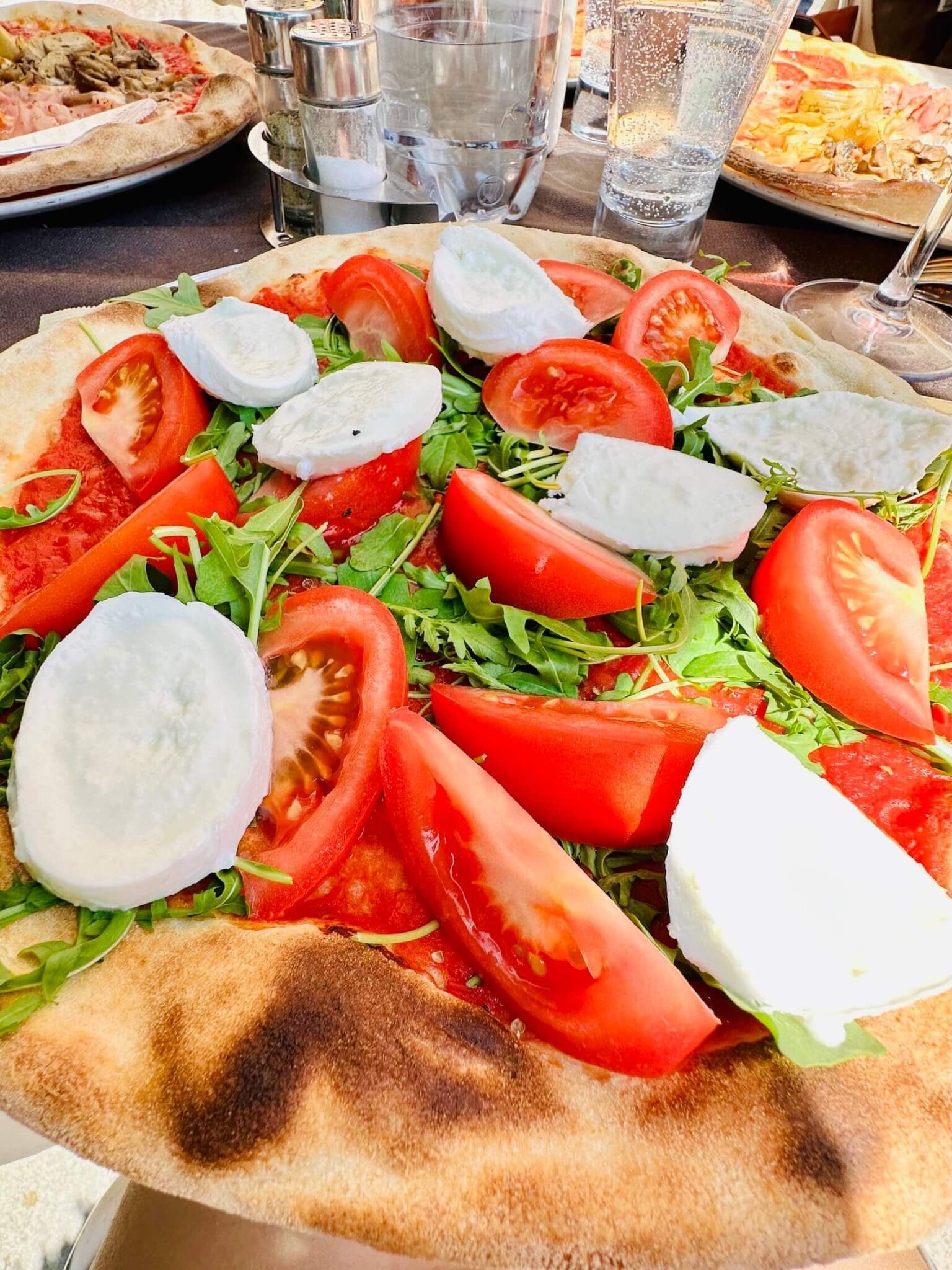
Like Venice, Murano is filled with colorful buildings, shops, gelato, and interesting church architecture. If you’re staying in Venice for more than 2 days, then you should consider a visit here. Plus, getting there by boat allows a more panoramic view of Venice.
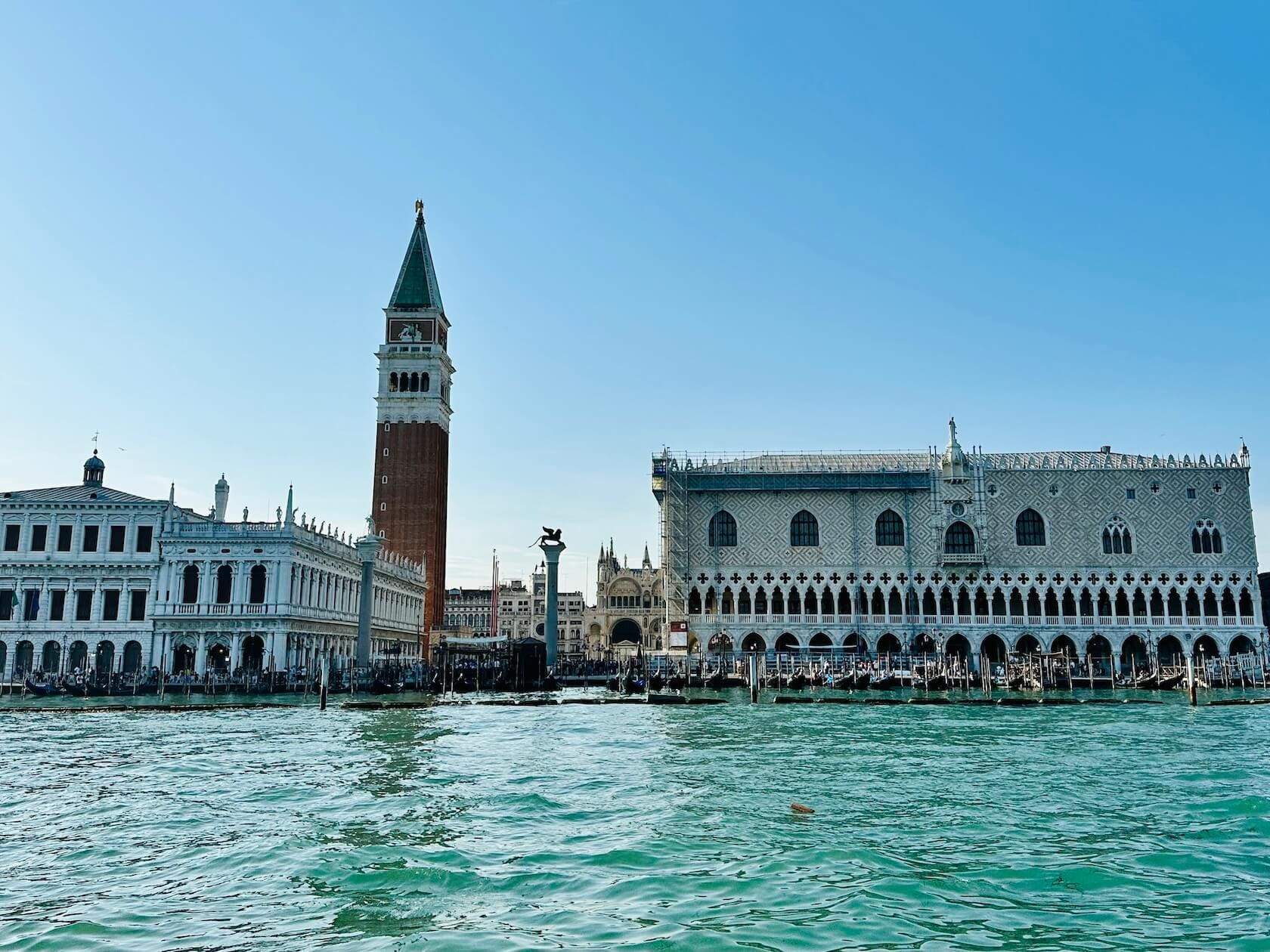
Getting to Murano
It’s a 20-minute boat ride from Venice to Murano on the Vaporetto (Venice Water Bus / Ferry). Taking the Vaporetto is the cheapest, fastest, and easiest way to traverse the canals and islands of Venice, but you do have to get the timing right or you will literally miss the boat.
I purchased a 2-Day Tourist Travel Card Vaporetto Pass for 30 euros from a self-service ticket machine at one of these major ACTV docks in Venice:
- Santa Lucia (Ferrovia/railway station)
- Piazzale Roma (Bus Station)
- San Marcuola
- Rialto
- Zattere
- San Marco
- San Zaccaria
- Fondamente Nove
Depending on your stay, you may want to purchase a single day or 3+ days. The main tip to remember is to buy it ahead of time, so you’re not scrambling with a defective kiosk.
7. Visit Basilica Maria Della Salute

The Basilica Maria Della Salute is free to access, and it is an exquisitely beautiful domed church that sits at the extremest tip of the Dorsoduro sestiere. If you’ve ever seen a movie set in Venice, you’ve seen this church.
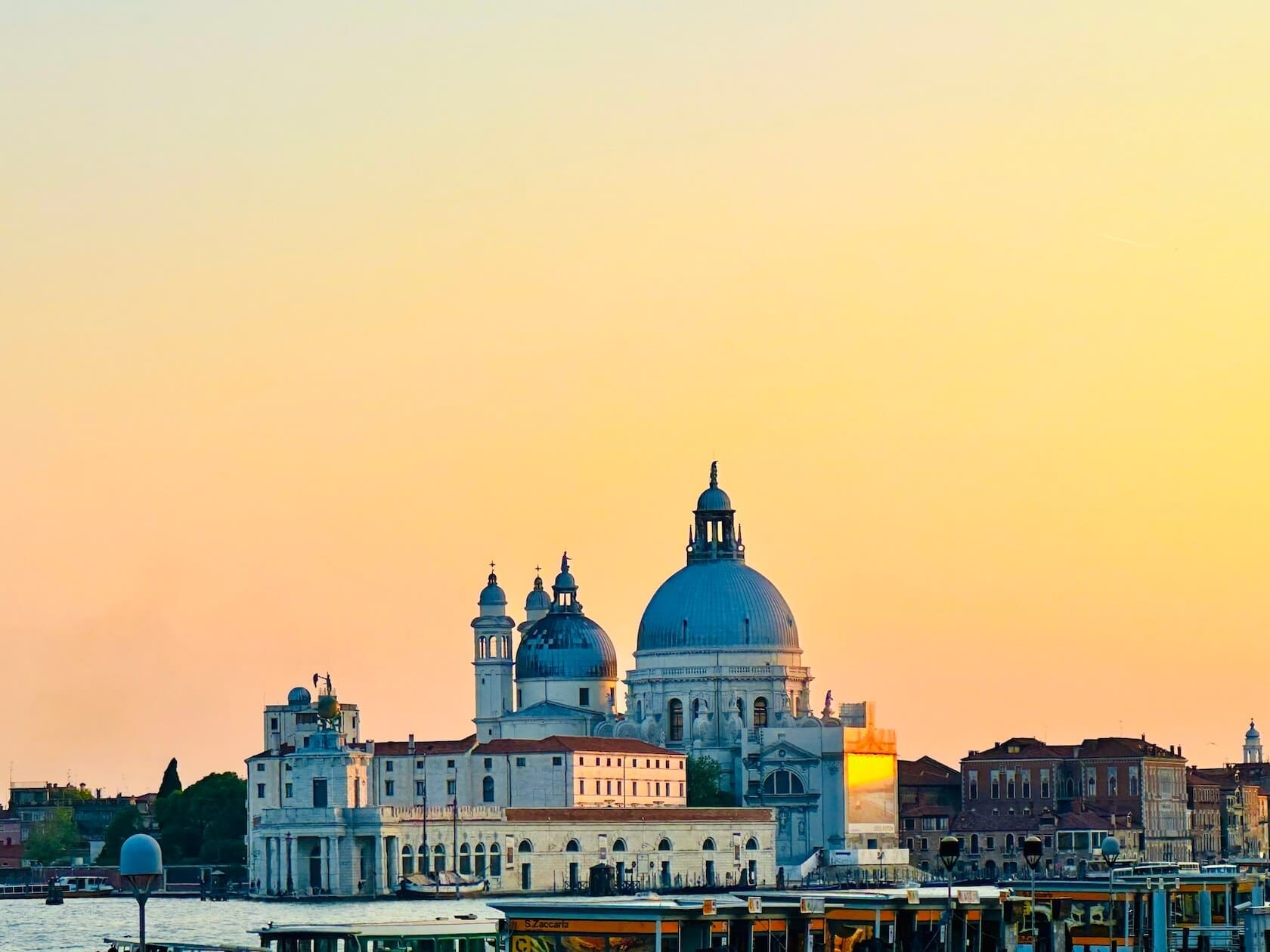
In October of 1630, a decree was made by the Venetian Senate that a new church would be constructed and dedicated to the Virgin Mary if the city could be saved from the plague that had already taken the lives of approximately one-third of Venice’s population.
Venice overcame the plague, and Baldassare Longhena, then only 26 years old, was selected to design the new church. It was consecrated in 1681, the year before Longhena’s death, and completed in 1687.
The basilica is circular in design and the interior is filled with intriguing sculptural details and a kaleidoscopic tile floor in shades of cream, black, and brown.
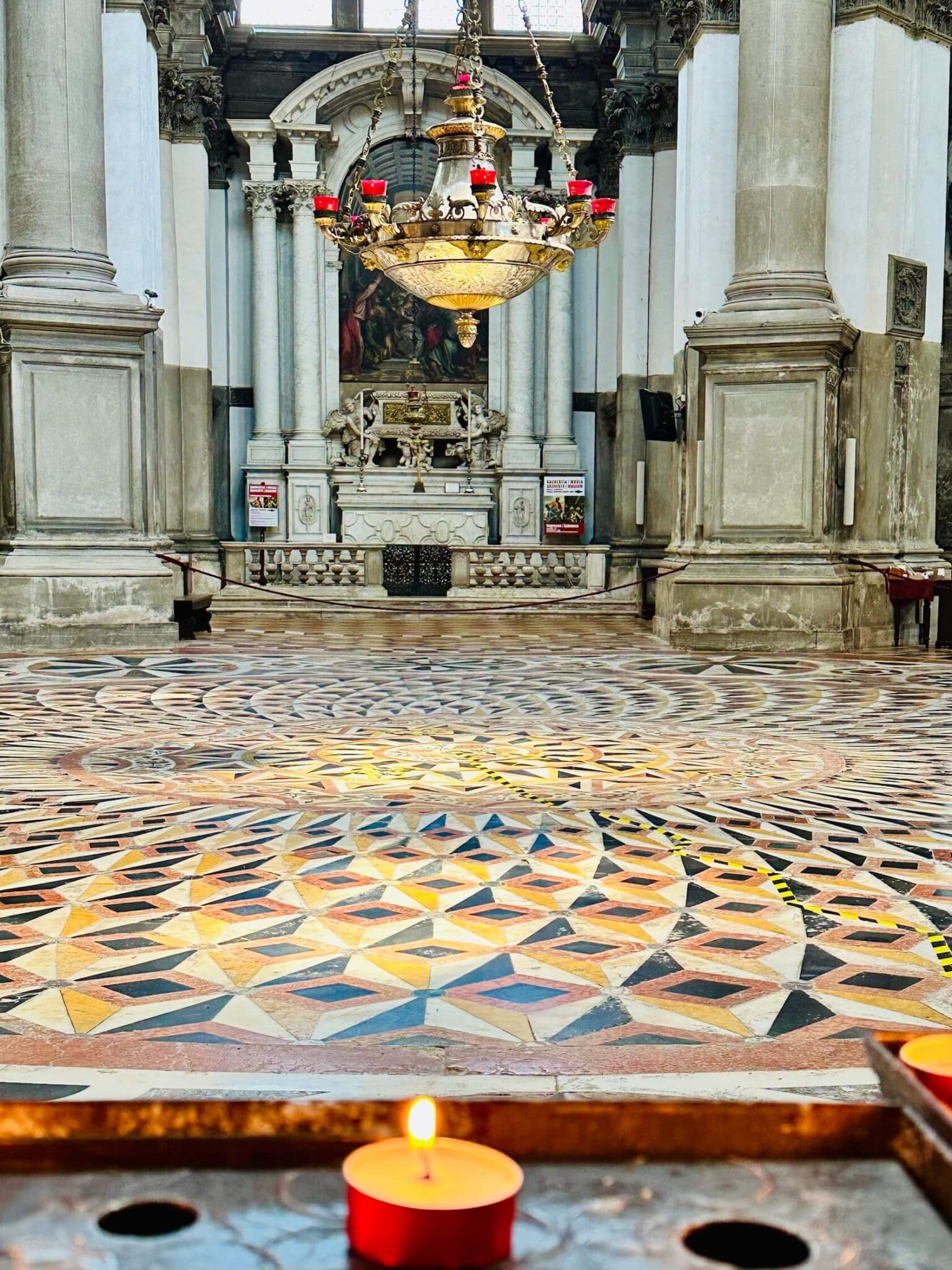
Note: Remember to dress appropriately by covering bare shoulders and not wearing shorts.
After you finish touring the Basilica, stop and take a moment to admire the views from the Basilica’s steps, looking towards St Mark’s Square and the tiny island of San Marino. The Guidecca Canal flows behind the basilica, where large yachts and commercial vessels are docked.
Around sunset, you may even be treated to some beautiful violin music played by local musicians in the nearby passageway behind the basilica leading into the Dorsoduro Sestiere.
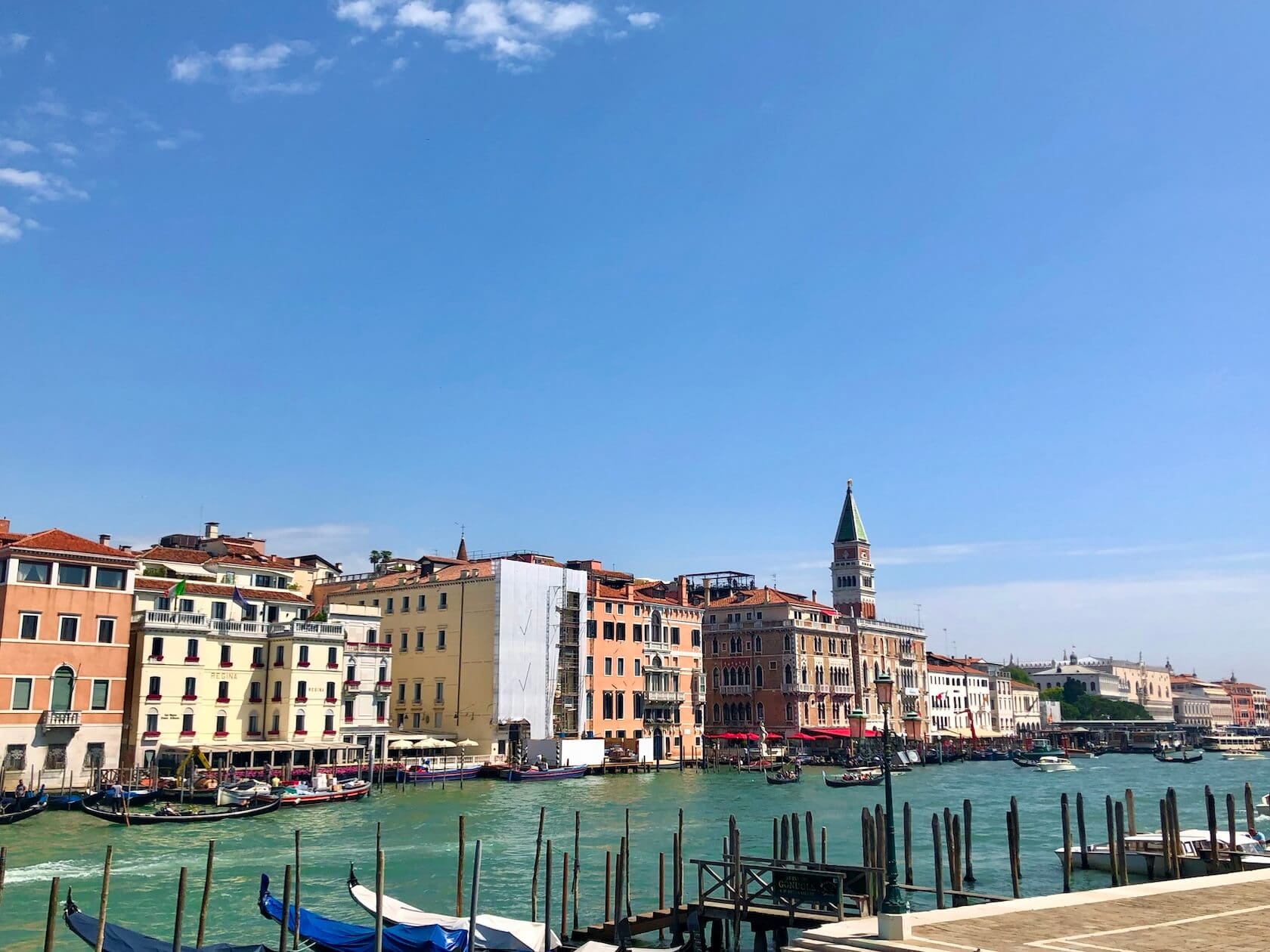
8. Visit The Peggy Guggenheim Museum
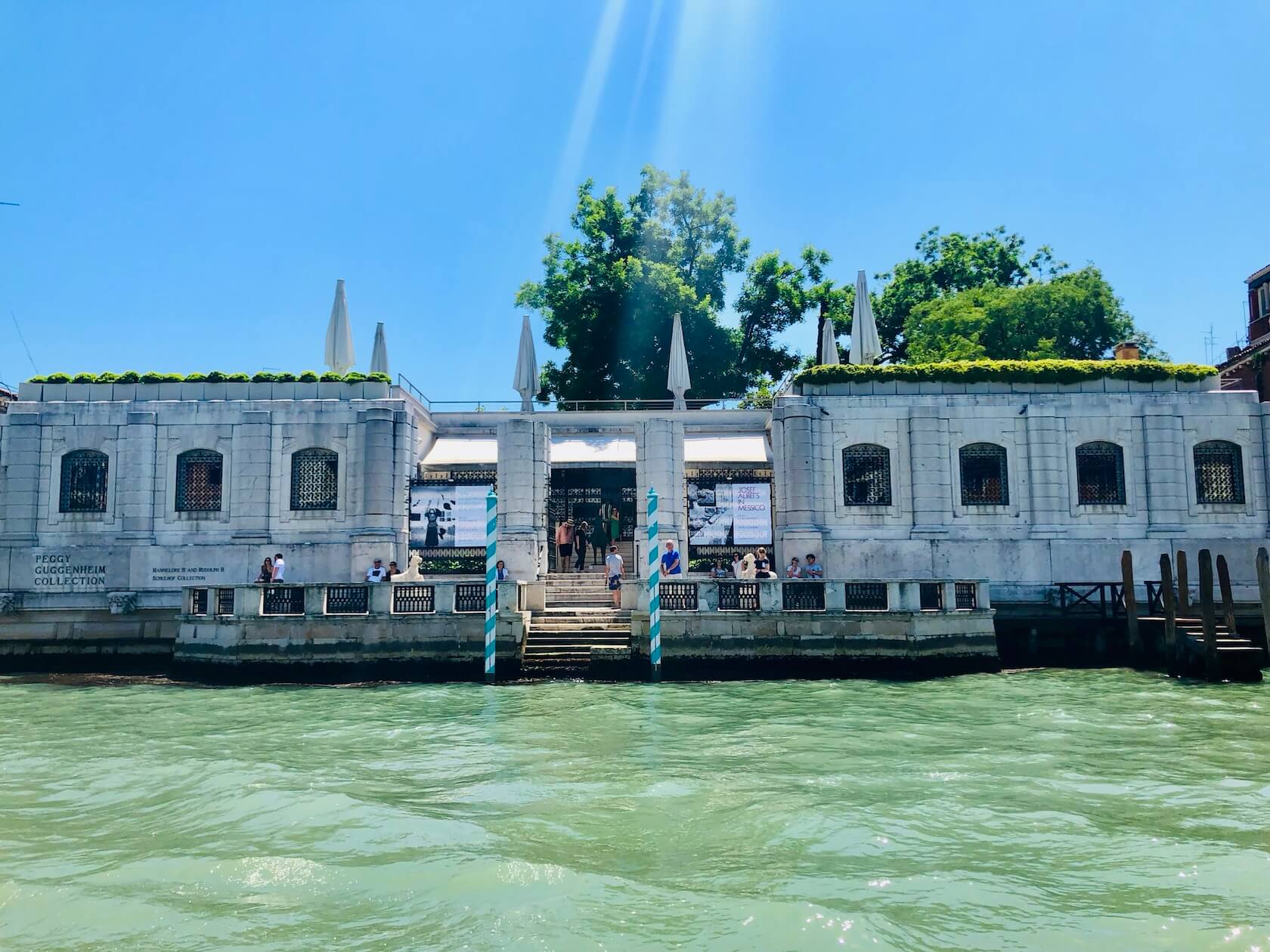
If you start to grow weary of touring basilicas and enjoy art, spend a morning or afternoon touring the Peggy Guggenheim Museum, displaying 20th-century works of art inside the Grande Canal palace that was her home, Palazzo Venier dei Leoni.
The permanent collection displays art and sculpture from well-known artists such as Picasso, Mondrian, Kandinsky, Pollock, and many more.
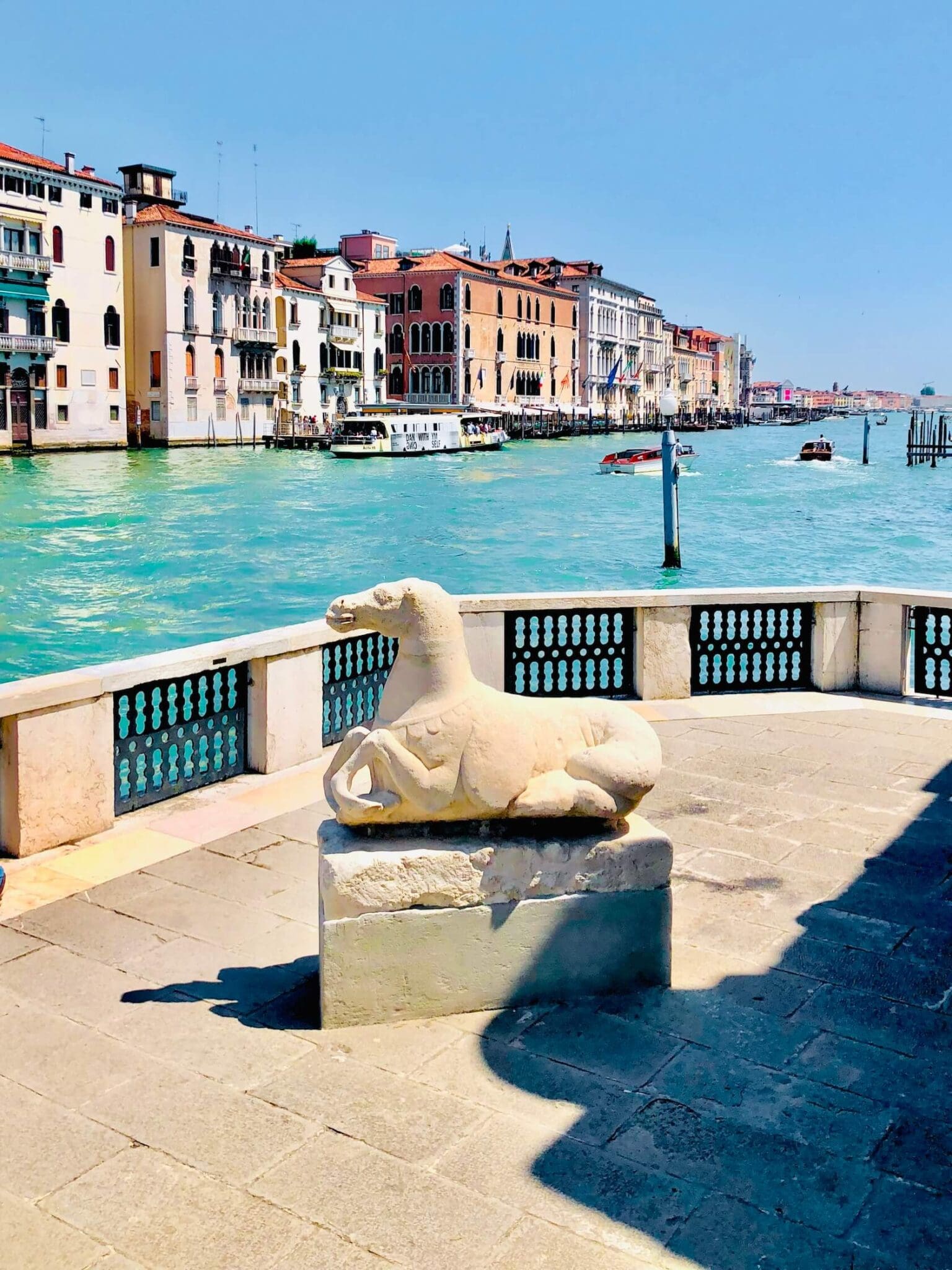
9. Explore The Cannaregio District
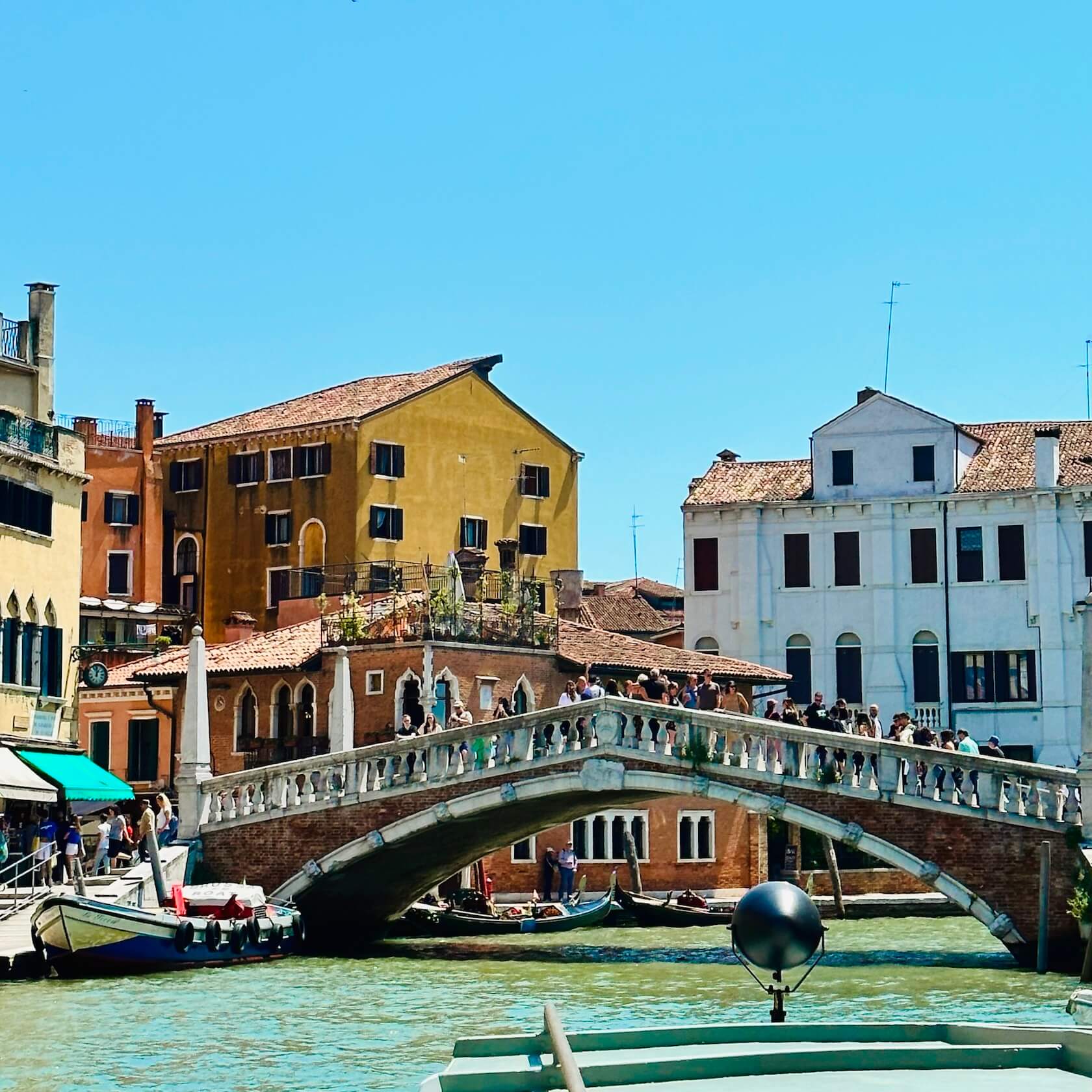
A largely residential district, a walk through the Cannaregio offers a decidedly different perspective on Venetian life.
If you’ve ever wondered where the term “ghetto” comes from, look no further than the Jewish Ghetto located in the historic Cannaregio district. The “origin of the term ‘ghetto’ is derived from getto, which translates to casting.
In 1492, Jewish refugees were forced to leave Spain and settle in the Cannaregio. The Jewish people were given a curfew, and armed boats patrolled the waters and the area.
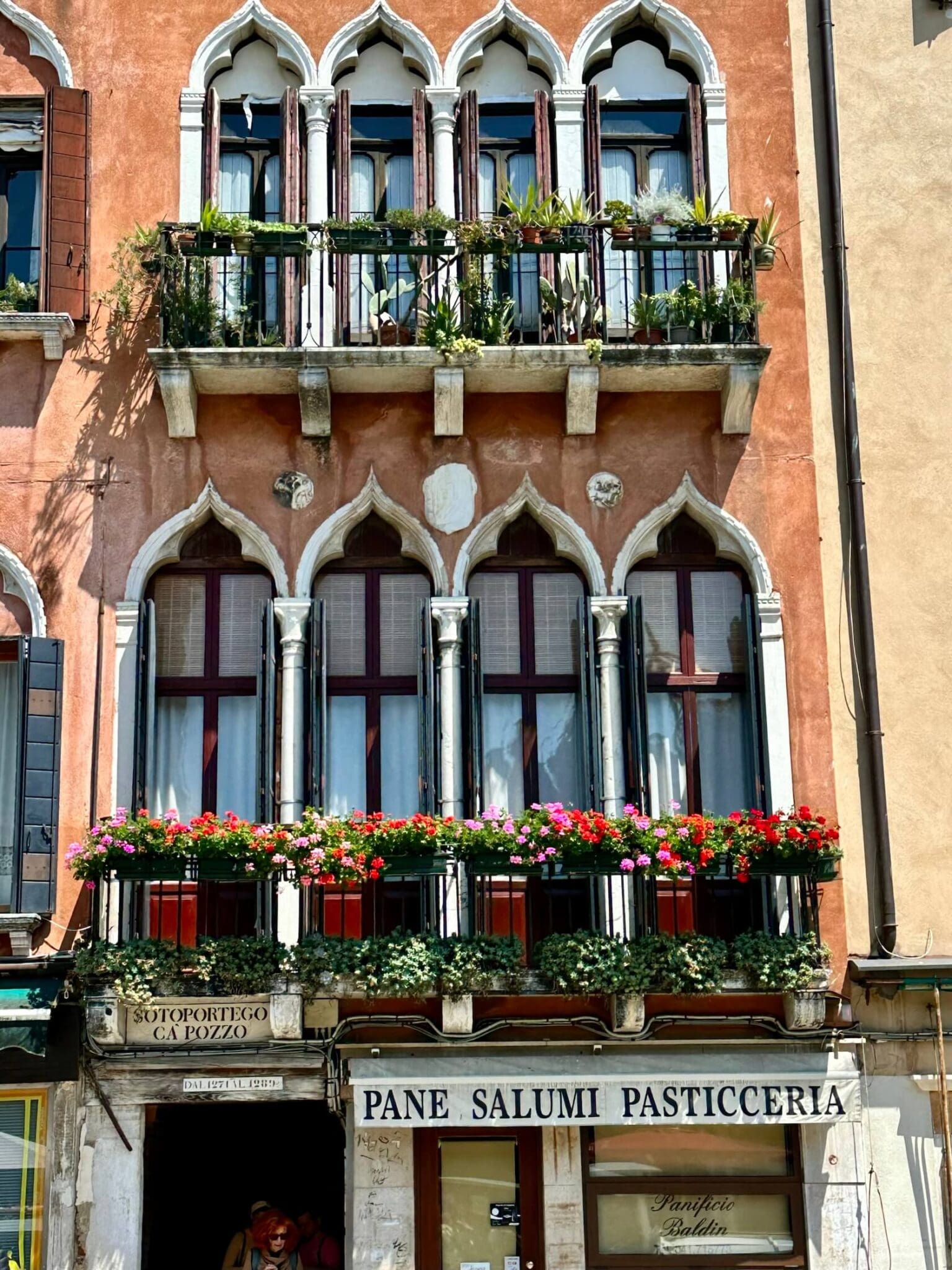
These days, the area is fairly quiet, with arching wooden bridges spanning the narrow canals. The Cannaregio area has more of a lived-in neighborhood vibe as opposed to the more touristy districts of Venice. Here you can find more authentic shops and cafes without the surge of the crowds.
If you’re in the mood to gamble, the Cannaregio is also home to the Casino di Venezia, officially the oldest casino in the world, dating back to 1638.
*Note: I haven’t visited the casino, so I can’t officially recommend it. Also, based on the Trip Advisor reviews, it might not be the best way to spend your time; however, it is a historic site and worth a mention.
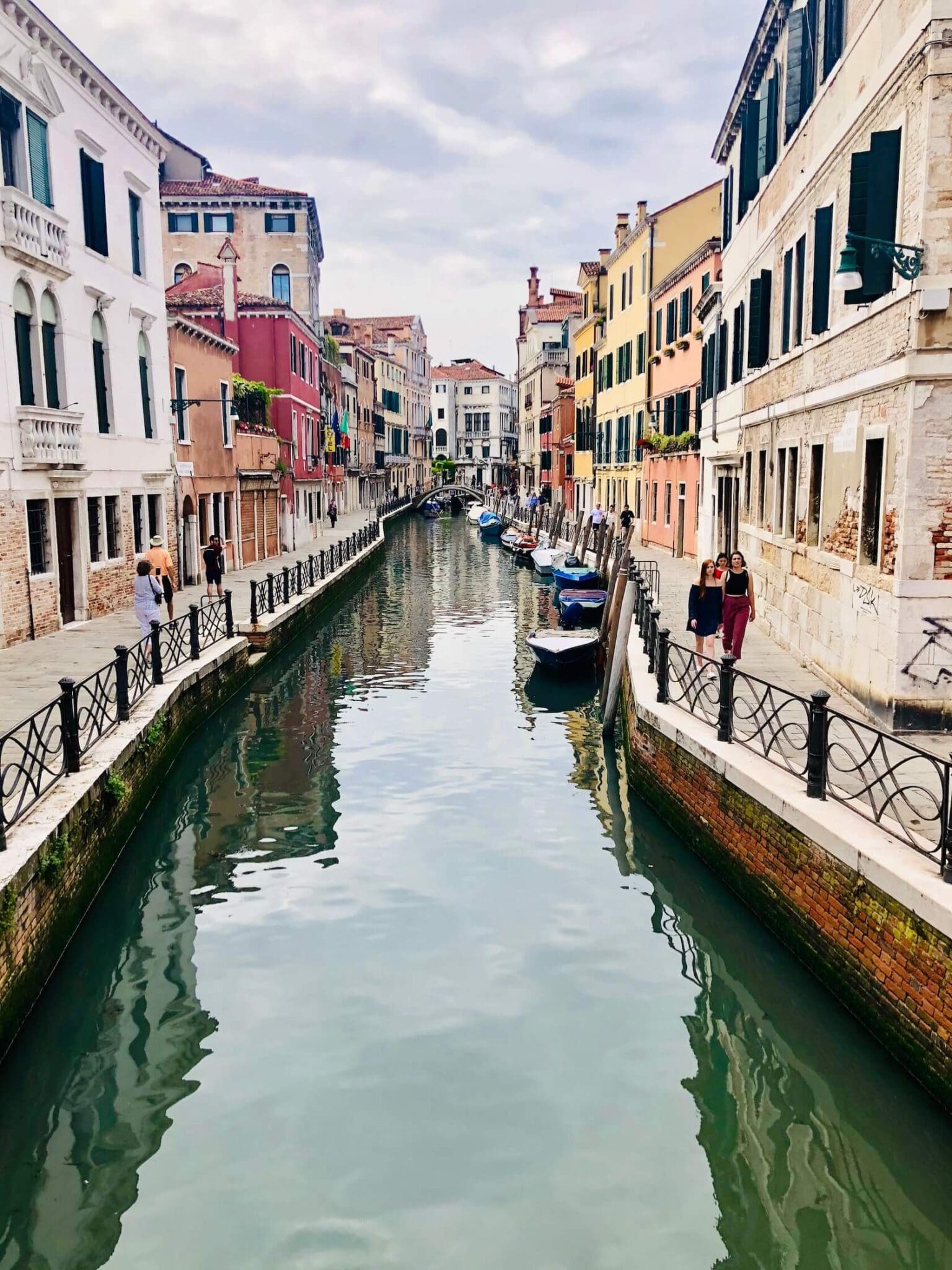
Best Places to Stay in Venice
The Sina Centurion Palace
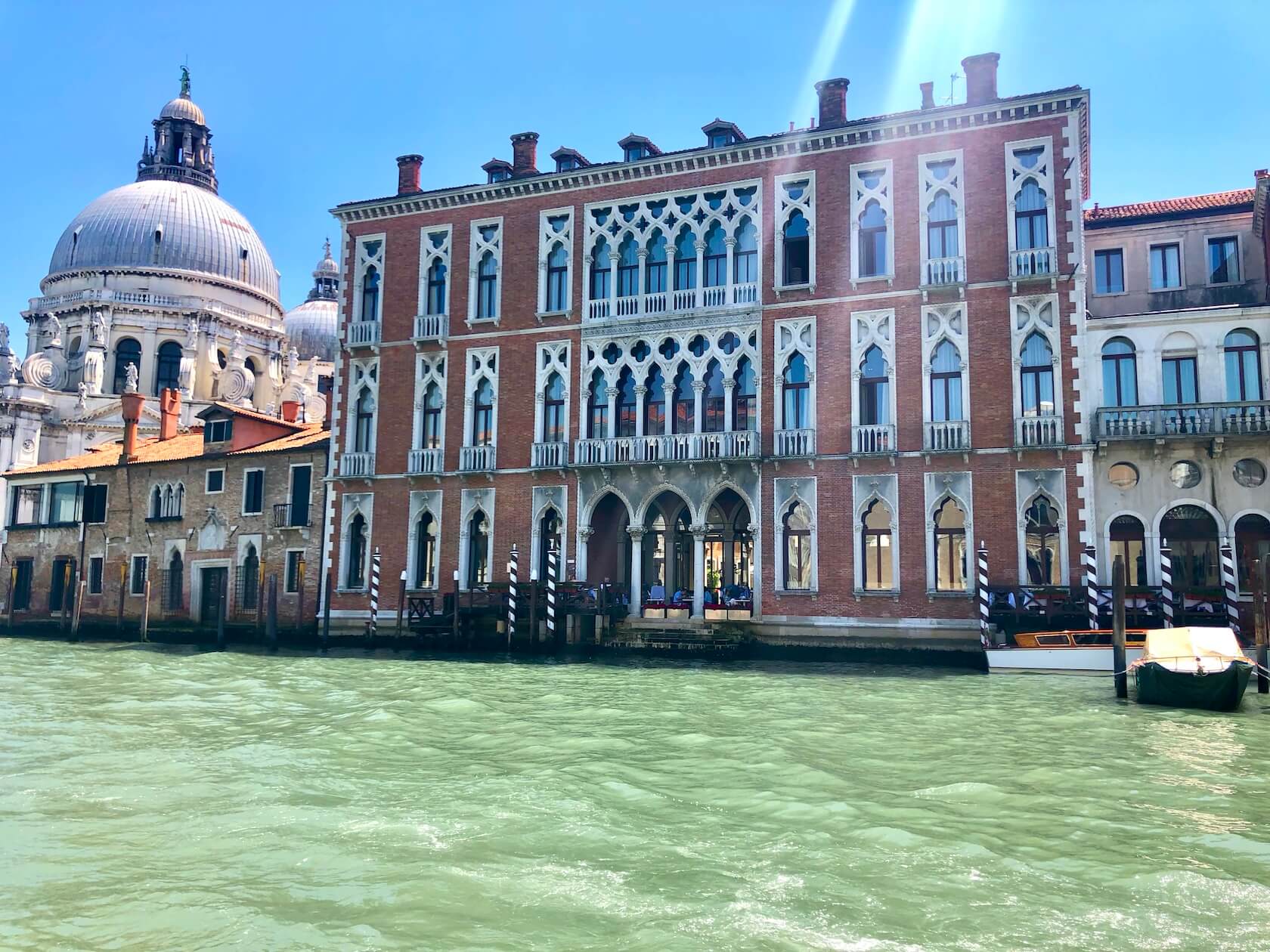
Housed in a former convent, the Sina Centurion Palace is ideally located on the Grand Canal in the Dorsoduro Sestiere next to the exquisite Santa Maria della Salute cathedral. This luxurious Venice hotel is also located within relatively easy walking distance to St Mark’s Square and other major Venice attractions.
A member of the Small Luxury Hotels of the World, the Sina Centurion Palace features 6 floors, 50 rooms, and 1 restaurant. Antinoo’s Lounge serves breakfast, lunch, and dinner with terrace views overlooking the Grand Canal.
The Hotel Danieli
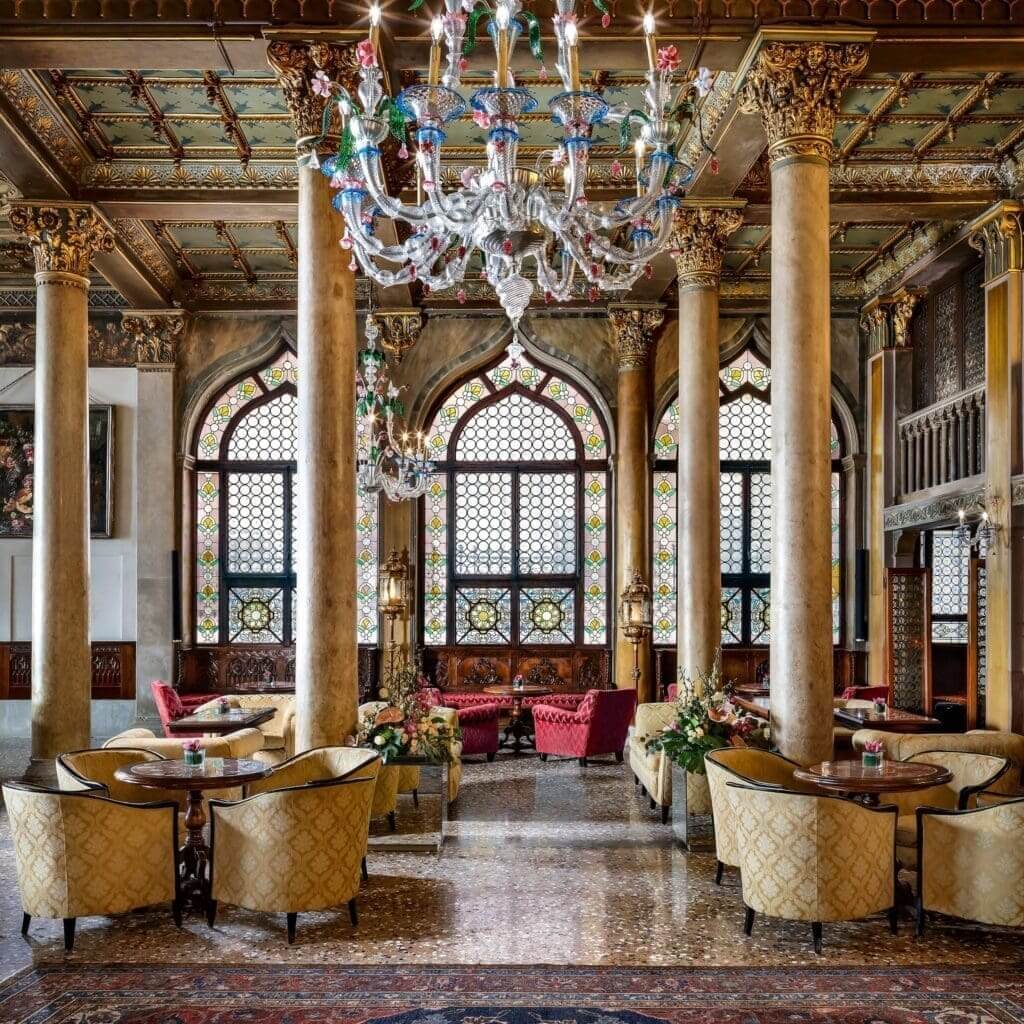
As far as prime locations go, you can’t get any better than the Hotel Danieli. The price to stay here, however, reflects that convenience and its lavish elegance, which is why I didn’t list it first.
Located on the Grand Lagoon, the Hotel Danieli is situated steps away from St. Mark’s Square. The Hotel Danieli actually consists of three palaces, each from a different century yet interconnected.
The earliest palace is the Palazzo Dandolo reflecting the Venetian Gothic style dating back to the 14th century. The second palace is the 19th-century Casa Nuova in the Baroque style, and the newest palace was built in the 20th century and named the Danieli Excelsior.
The hotel offers a fine dining rooftop terrace restaurant, the Terrazza Danieli that is available to book on OpenTable. If you’d like to enjoy the rooftop terrace without committing to an expensive meal, the Bar Terrazza offers the same rooftop views with light bites and beverages between the hours of 1:00 pm to 6:30 pm.
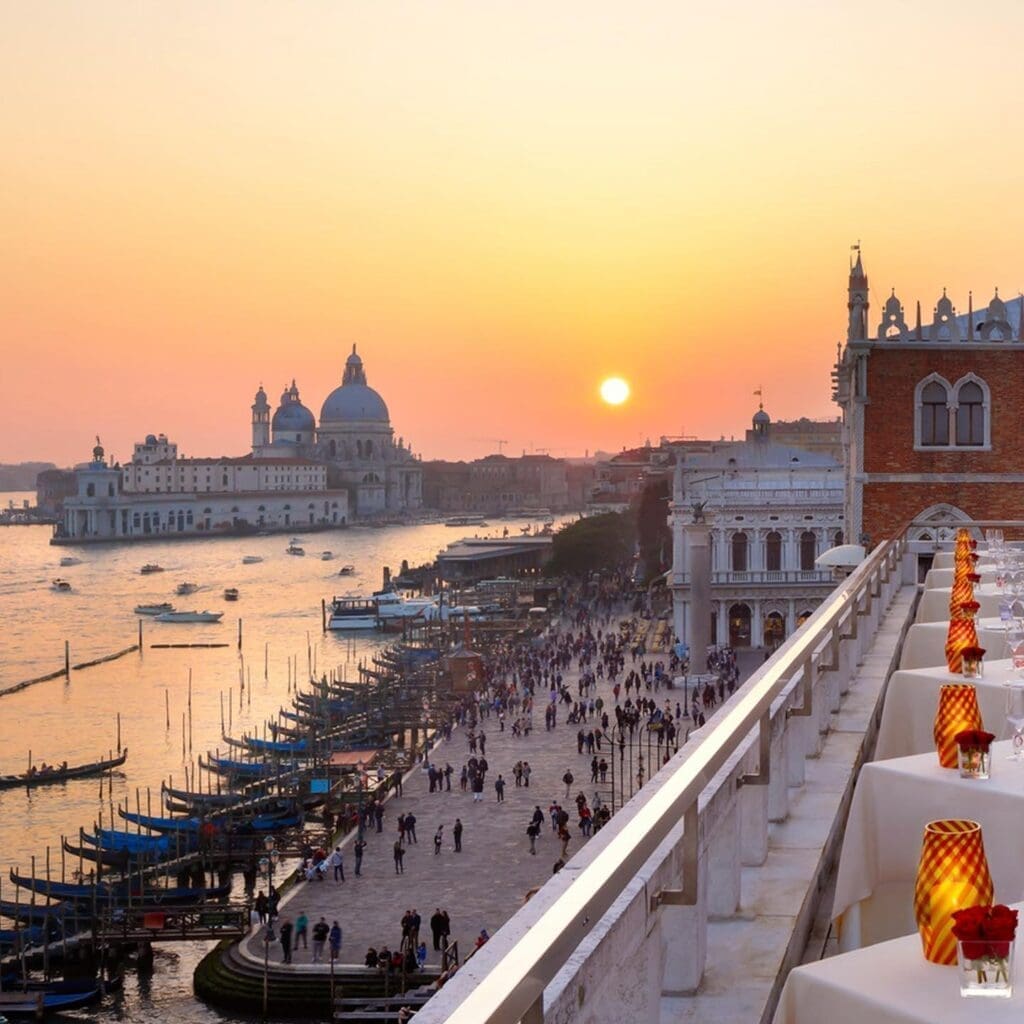
The Bar Dandolo is a beautiful indoor salon for classic drinks and afternoon tea with piano music in the evenings.
The Gritti Palace
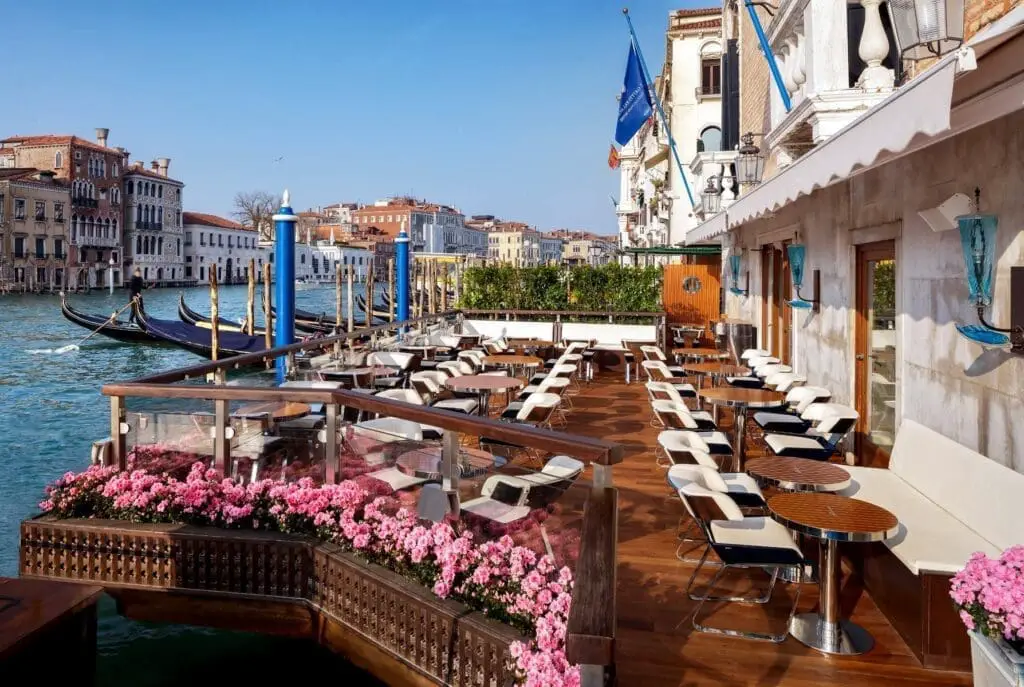
Much like the Hotel Danieli, the Gritti Palace is a destination unto itself. Located at a prime location directly on The Grand Canal with views of the Basilica Maria Della Salute to the left, the Gritti Palace dates back to 1475. A former palace, this luxury 5-star hotel is exceptionally elegant.
Even if you don’t get a chance to stay here, you can always enjoy food and drinks on the Gritti Terrace.
St Regis Venice
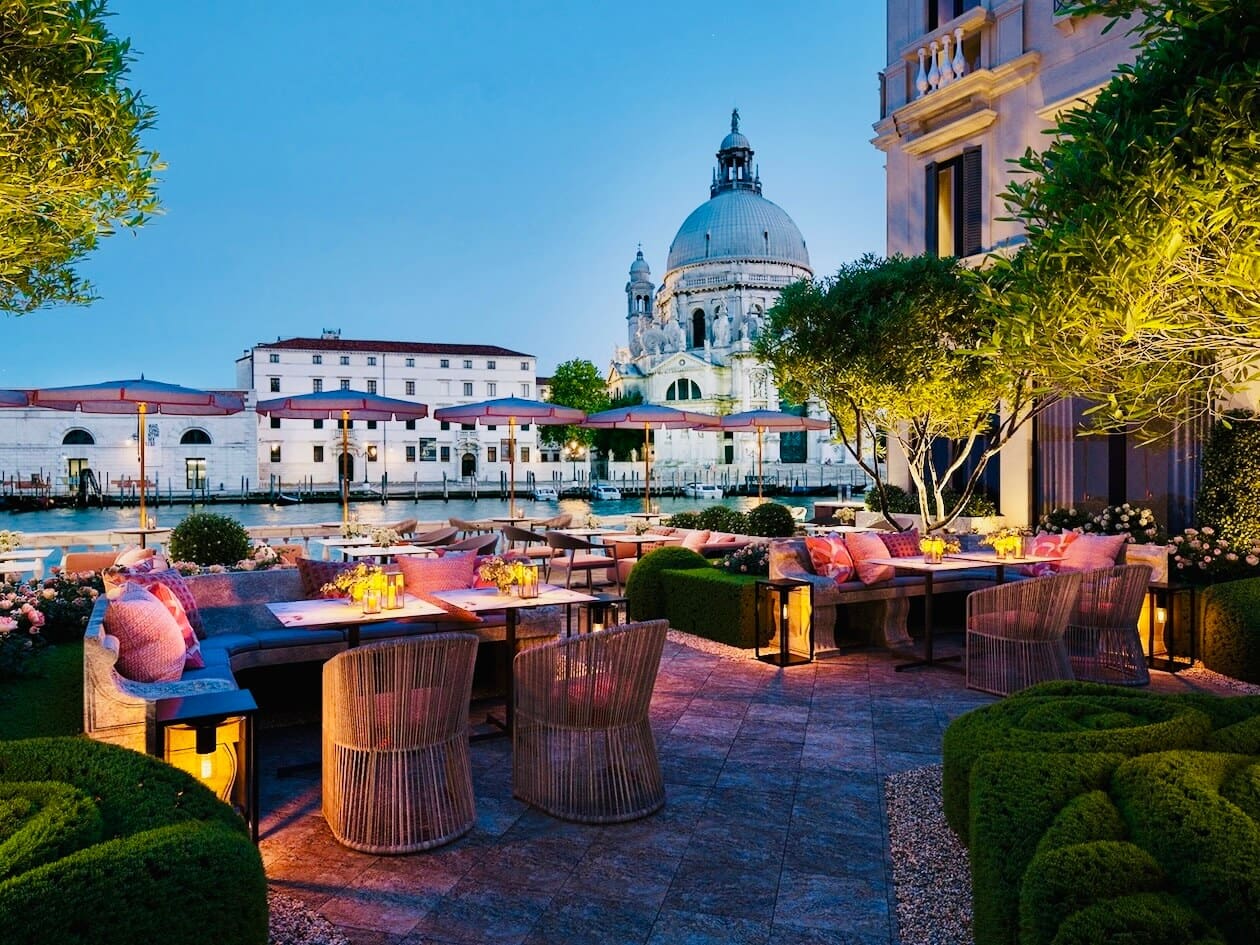
The St Regis made its debut in Venice in 2019 after a full-scale renovation of the former Grand Hotel Britannia. The St Regis offers 126 guestrooms and 37 suites, many of which have a private terrace which is a rarity in Venice.
Another unique element of this Venice hotel is the Ginori Garden. While many of the luxury hotels in Venice offer a terrace overlooking the canal, St Regis also has a private garden escape in addition to its large terrace.
St Mark’s Square is only a 4-minute walk away, making the St Regis an excellent location for your stay.
Charming House (DD724)
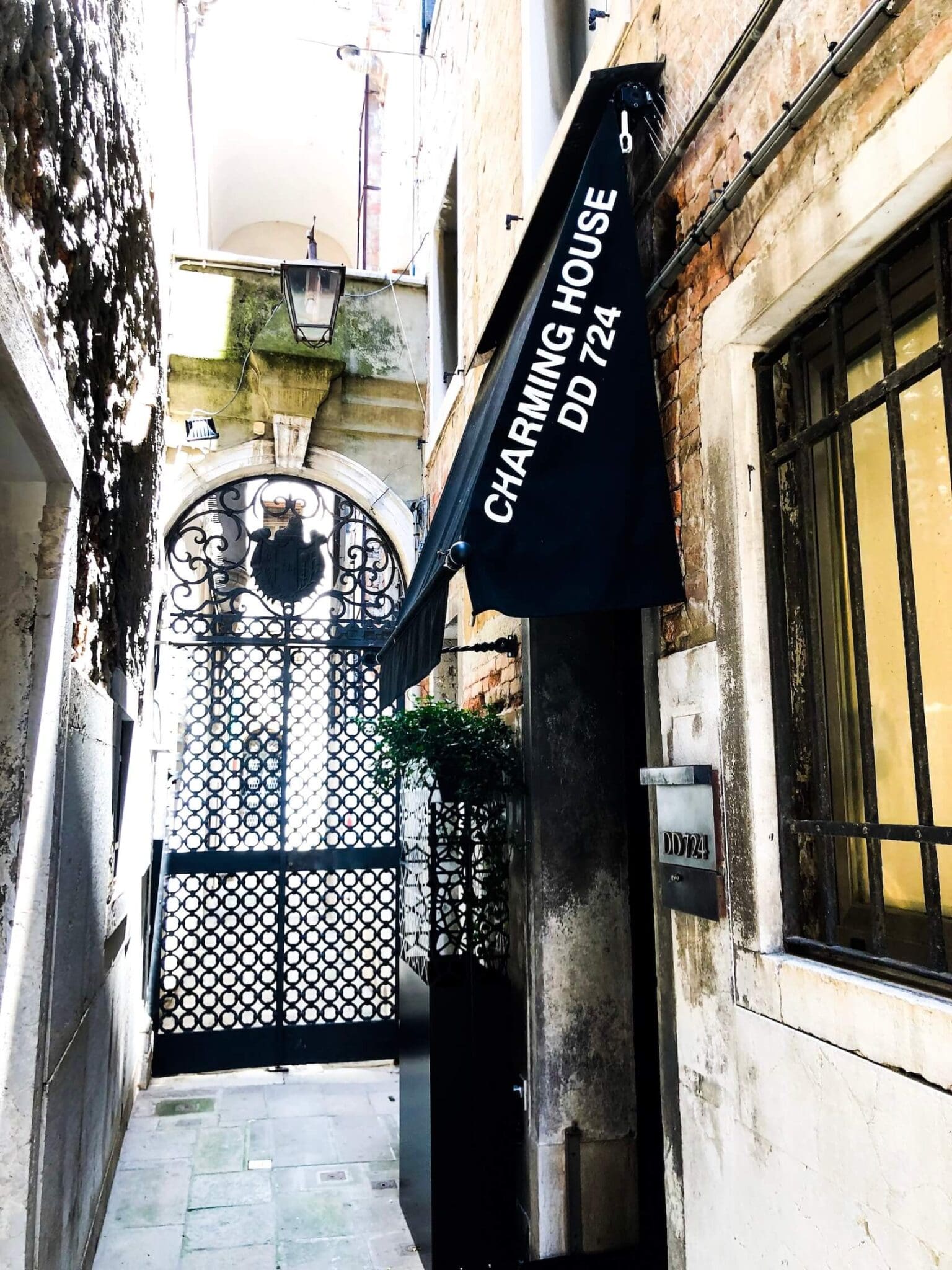
If you’re looking for a more spacious room in Venice with a uniquely personal touch, then you will love The Charming House, Apartment DD 724.
While the Charming House offers rooms all over Venice, the DD 724 room is located in the Dorsoduro Sestiere, with easy access to water taxis and ferries and within walking distance to most major attractions.
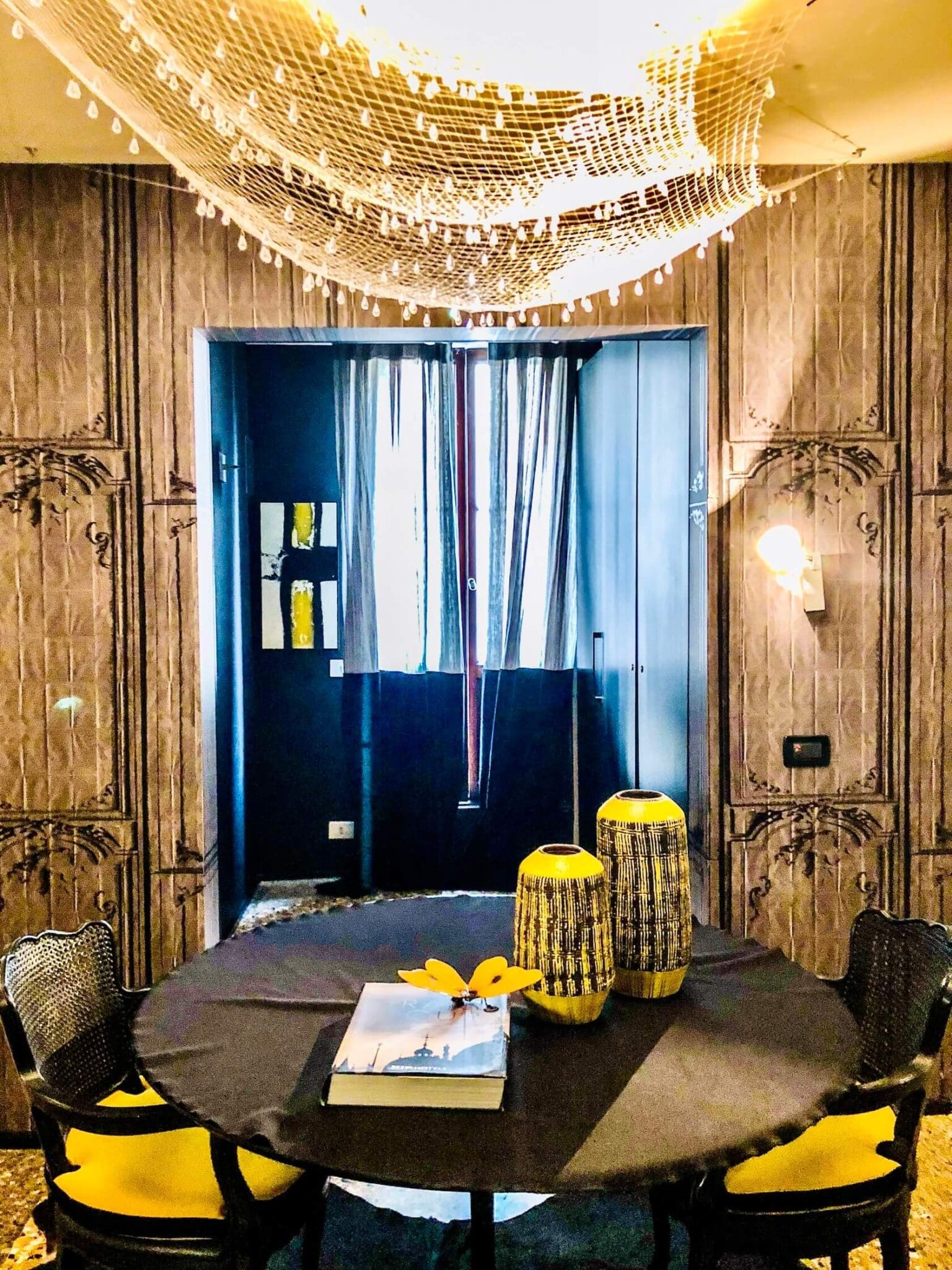
Torn between staying at a traditional hotel versus a boutique hotel in Venice like the Charming House? Consider the following:
*Cost: Charming House is less expensive than a traditional hotel. Most Venice hotels near St Mark’s Square are in high demand, making them difficult to reserve and also quite expensive.
*Convenience: Charming House offers a delicious breakfast and a friendly staff for concierge services, but there isn’t an on-site restaurant for those nights when you want to dine on property or in the room.
*Space: If you want a more spacious room without breaking your travel budget, opt for the Charming House.
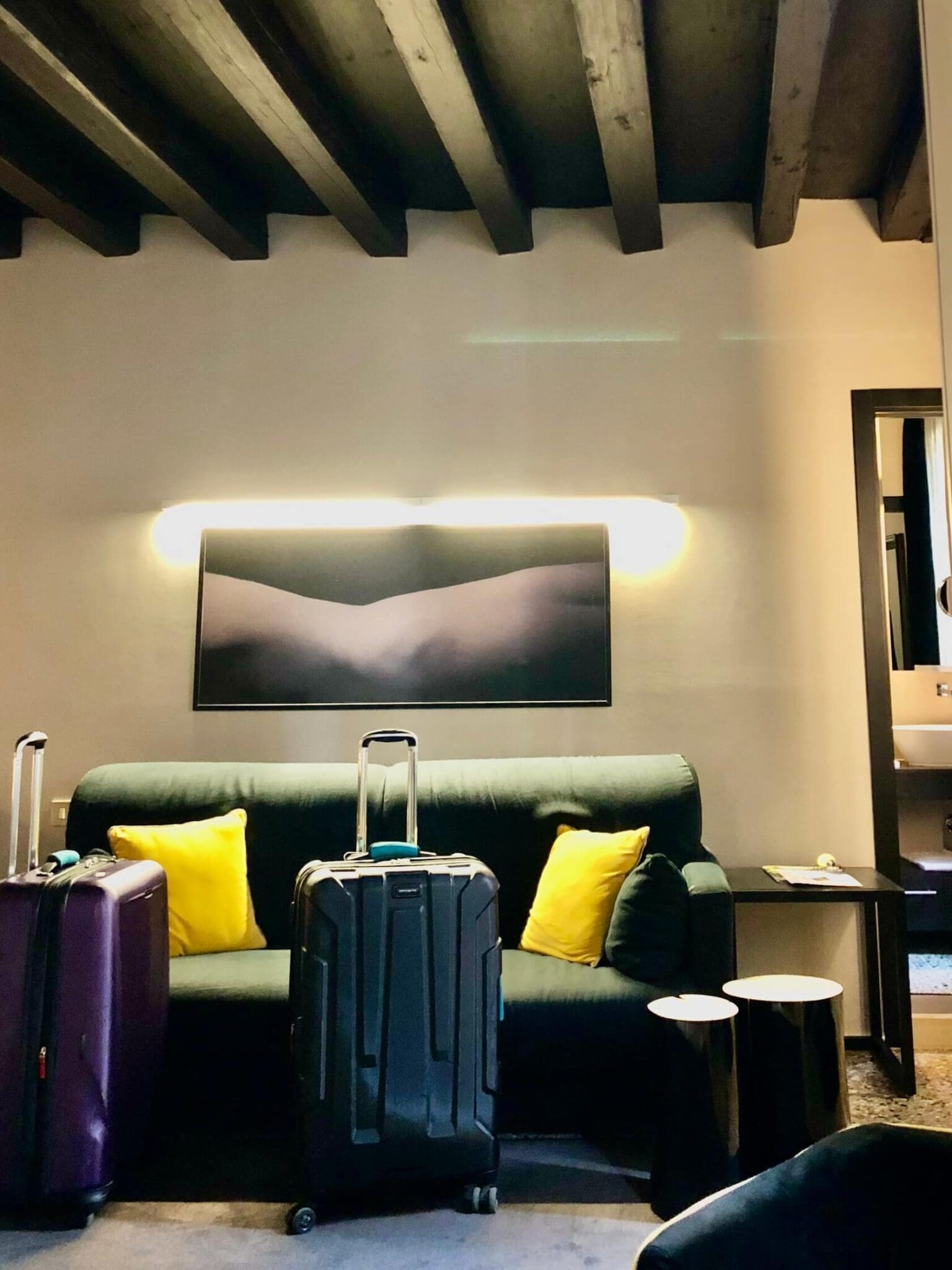
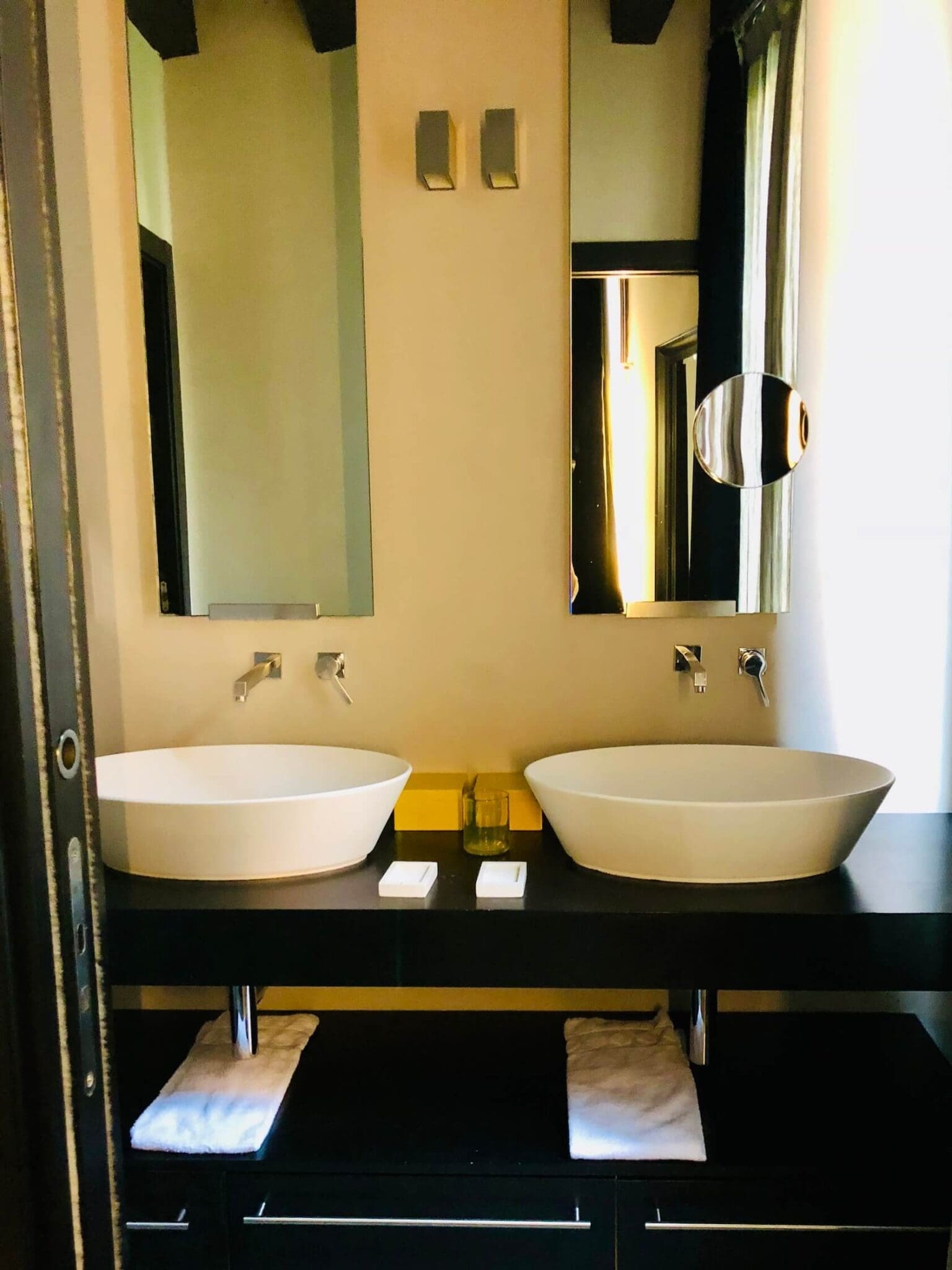
J.W. Marriott Venice Resort & Spa
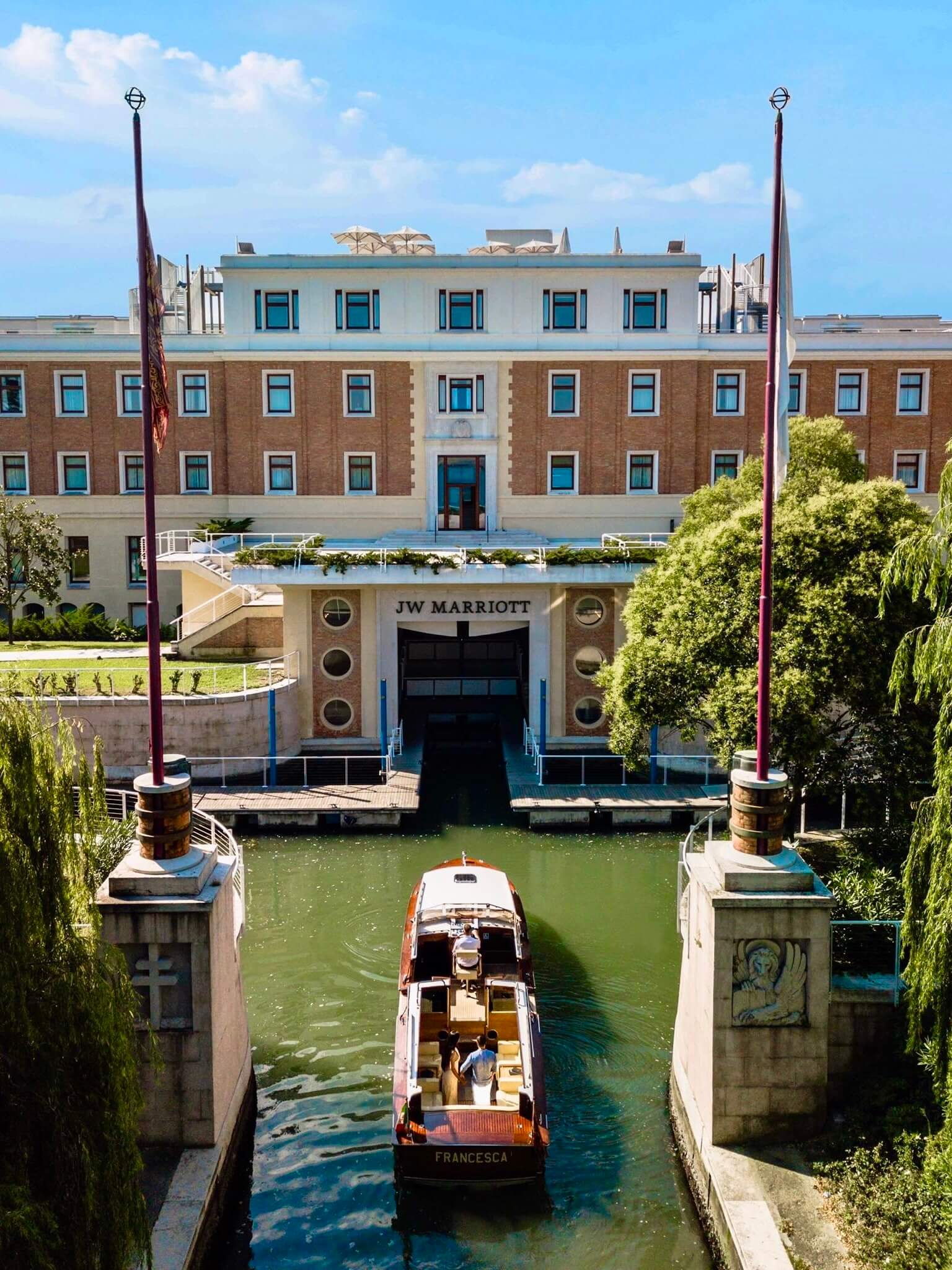
If you’re looking for a more unique stay in Venice, then consider the J.W. Marriott Resort & Spa situated on 40 acres brimming with gardens and olive groves.
Located on the private island of Isola delle Rose just across the Grand Lagoon, guests of the hotel can ride their complimentary shuttle boat from their private pier at St. Mark’s Square, which takes 20 minutes.
You can relax in their rooftop pool and take in the Venice skyline in the distance.
The hotel has several dining options with a focus on freshness. Many of the vegetables and herbs are grown on-site in the gardens. If you want to take your culinary experience further, you can take a class at their Sappori Cooking Academy.
Best Places to Eat in Venice
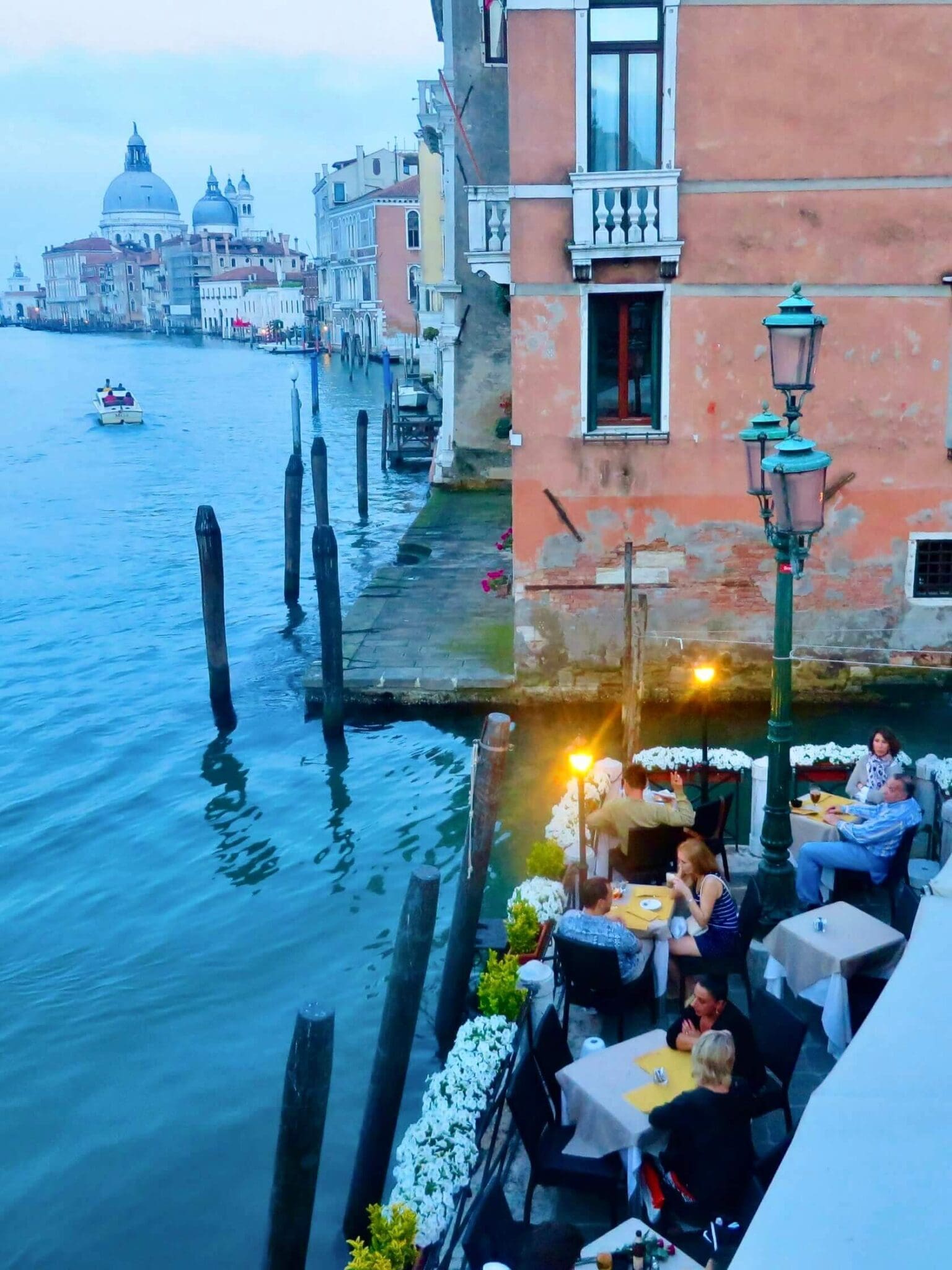
While you can find any type of food you like in Venice, fresh seafood is their specialty. If you want more authentic cuisine and also avoid the tourist trap (a.k.a restaurants with pictures of food on the menu outside), then getting a reservation is basically a must.
You can see what restaurants are available to reserve on Quandoo or “The Fork” (online reservation systems similar to OpenTable). You can also check a restaurant’s website for reservations by email or by calling ahead. If you’re nervous about your Italian language skills, then ask a concierge to make the reservation for you.
However, since many Italians, particularly those in the restaurant industry, speak English, you’ll most likely be fine if you decide to make the reservation on your own.
Because Venice is such a vast tourist hot spot, finding authentic cuisine away from the crowds can be difficult; however, there are quite a few gems.
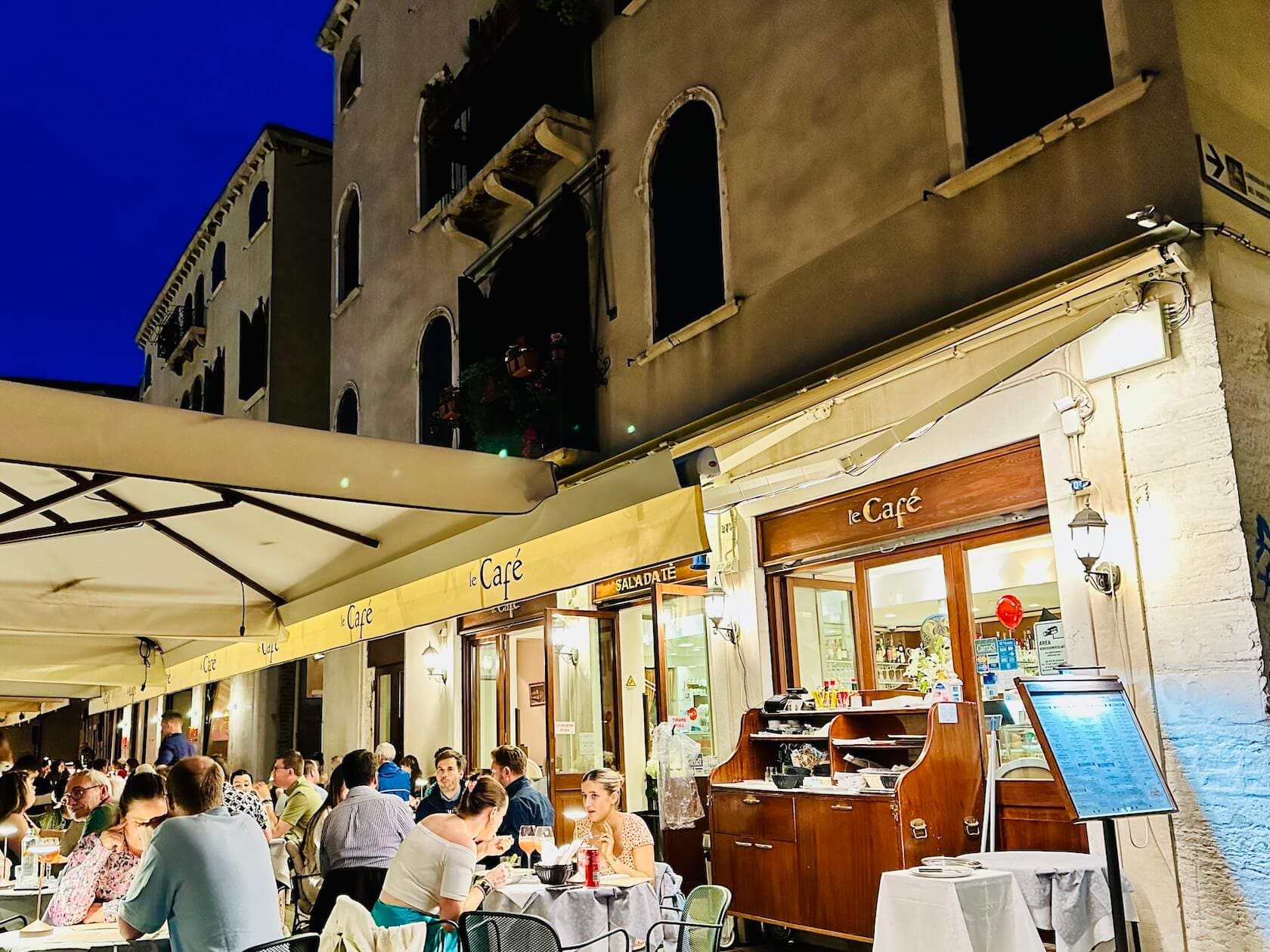
Best Lunch & Dinner in Venice
Ristorante La Piazza: Located a few steps behind St Mark’s Square, this restaurant has a warm and inviting atmosphere with delicious food. Due to the popularity of this restaurant, it may be difficult to get in, so the best option is to book in advance. Click this link for reservations.
Taverna San Trovasa: Situated on a corner in the Dorsoduro sestiere, the Taverna is a bustling, friendly establishment with a satisfying selection of pasta and seafood options. Unlike most of the smaller osterias, this tavern can accommodate larger groups.
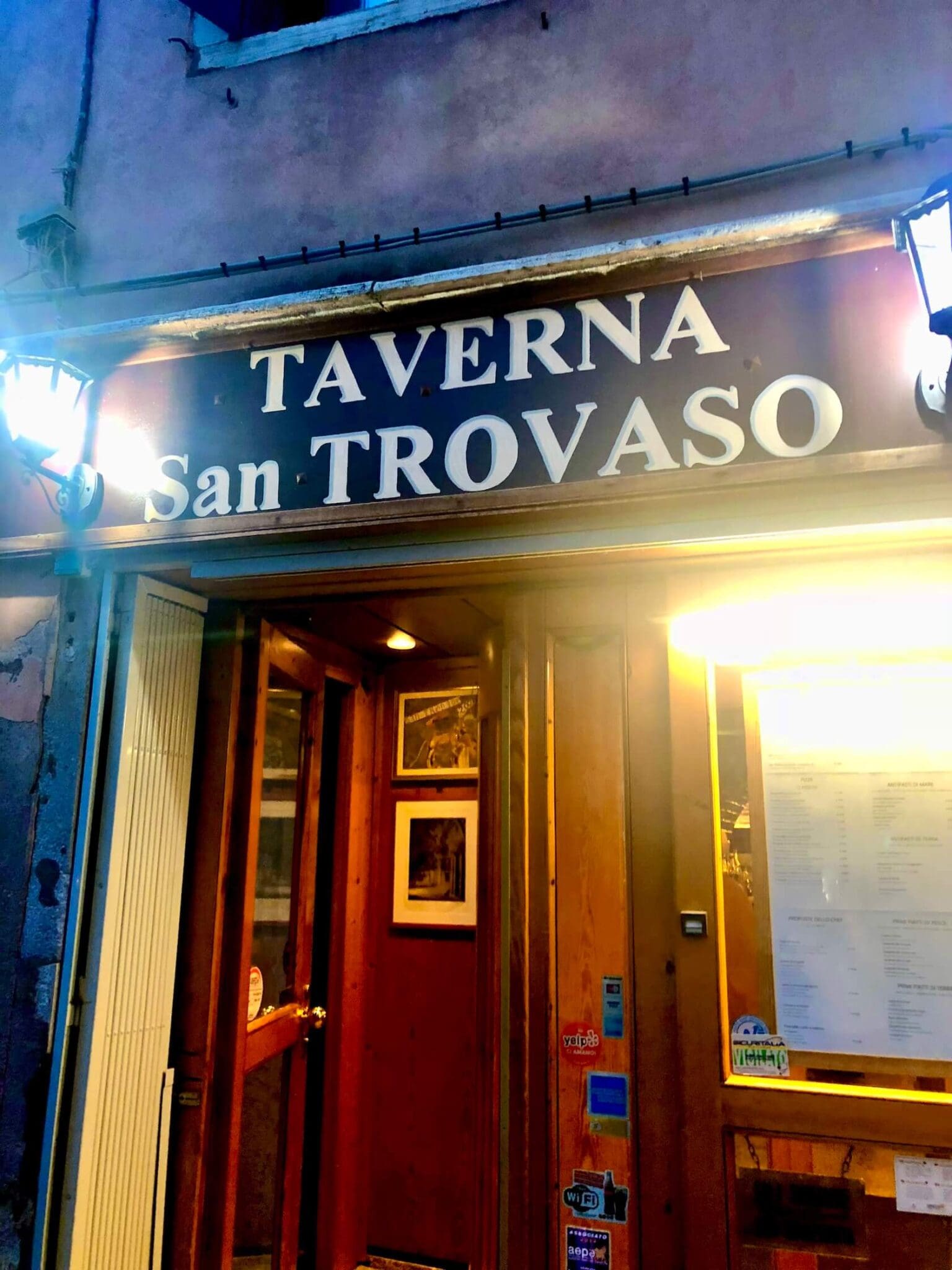
Ai Gondolieri: While a bit more pricey, Ai Gondolieri is a historically interesting spot due to the many famous people who have dined there through the years. After dining there myself, I can understand the reason for its popularity—truly delicious food with close attention to the tiny details. The appetizers of fried zucchini flowers and the traditional Caprese salad were highlights, and their selection of housemade desserts was outstanding. They do accept reservations either by calling in advance or emailing them.
Al Gobbo di Rialto: Located near the Rialto Bridge & Market, Al Gobbo di Rialto is romantic with its soft lantern lighting and warm brick interior. The food was fresh, seasonal, and tasty, and the desserts were a particular standout. You can reserve this restaurant in advance by calling or emailing them.
Trattoria Al Gazzettino: I visited this Trattoria for lunch during my last stay in Venice, and it was one of the most friendly and welcoming establishments we visited. Eating here was an experience, with the waiter bringing us little extras to sample as well as a complimentary digestivo. You can reserve a table by calling ahead.
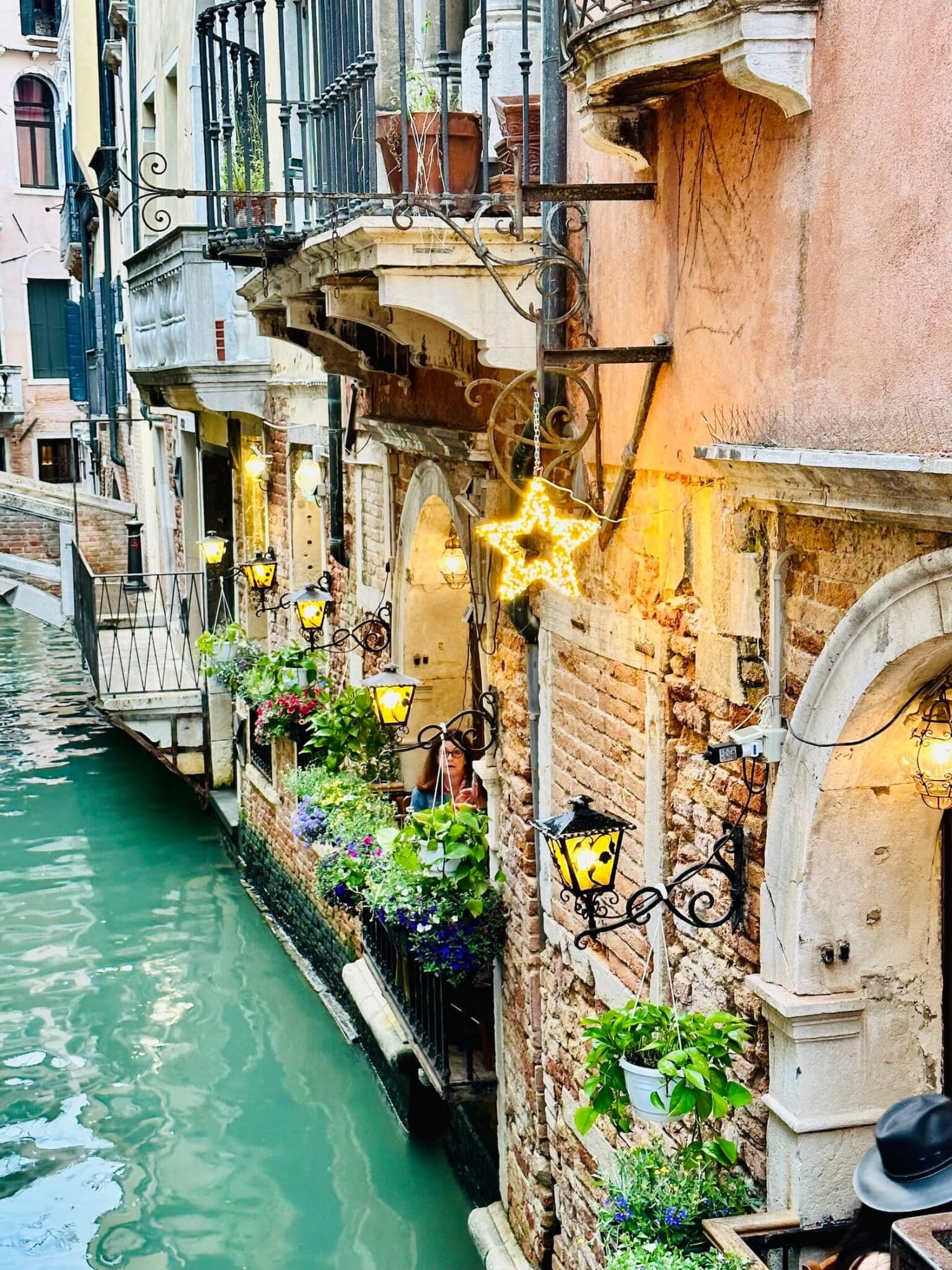
Osteria Ai Do Gobbi: Located in the Castello Sestiere, this tucked-away Osteria is situated in an area with fewer tourists. The menu features seafood primarily, but traditional pasta dishes are also offered. They offer reservations via Quandoo.
Al Vecio Marangon: This tiny, charming restaurant is easily missed but is popular with tourists and locals alike. The carciofe (artichoke) appetizer is tender and savory, and the eggplant ravioli topped with pomodoro sauce along with the cannelloni bolognese is stellar.
Osteria Fanal del Codega: This osteria offers traditional yet sophisticated Venetian entrees with fresh seafood options as well as classic meat courses along with vegetarian dishes. It’s a popular destination for dinner, but you can make a reservation on their website.
Best Cocktails & Aperitivo in Venice
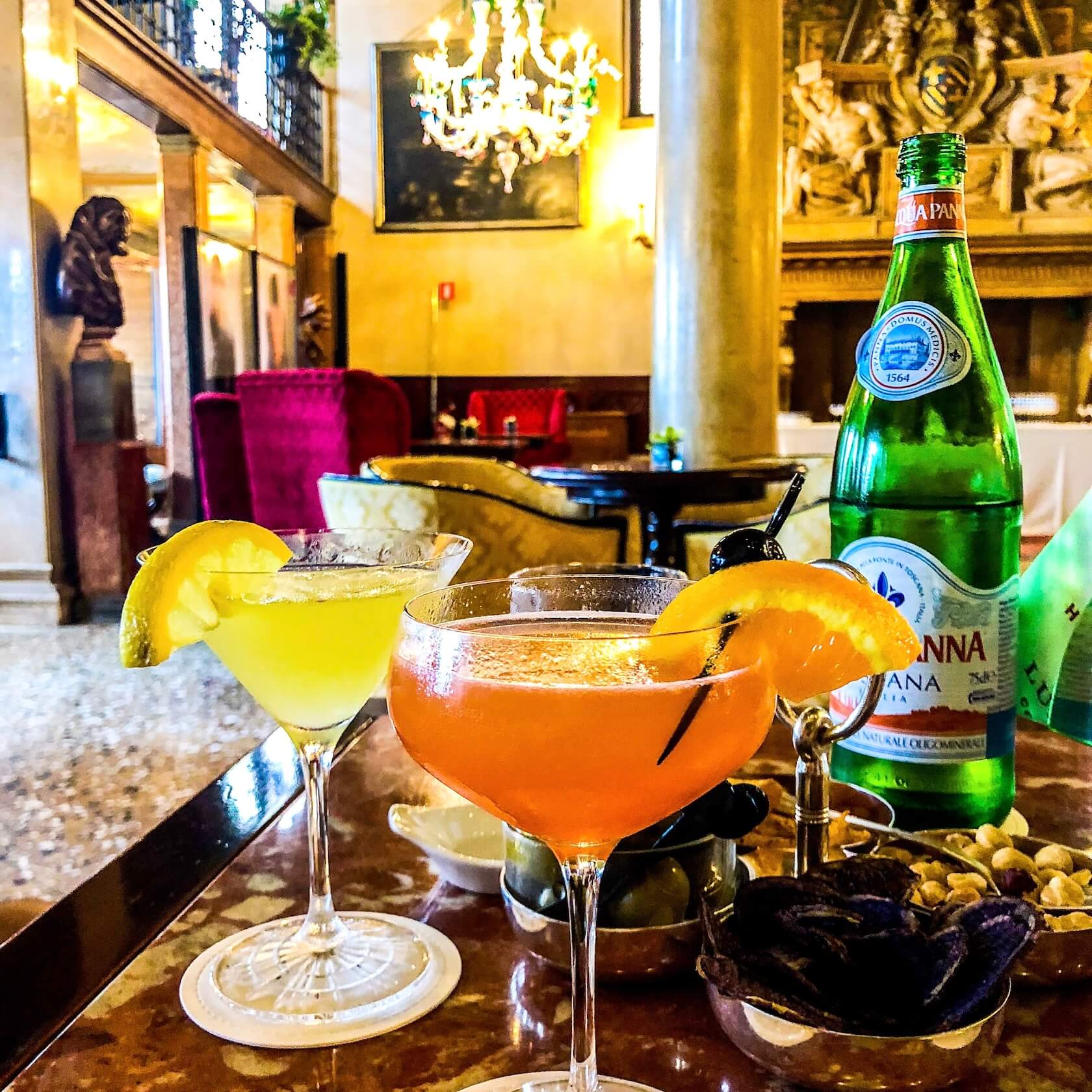
Bar Dandolo at the Hotel Danieli: Whether or not you get the opportunity to stay at the grand and glorious Hotel Danieli, carve out a little time to sink into the velvet cushions of the Bar Dandolo and sample their aperitivo when you visit Venice.
To call it “opulent” doesn’t even do it justice. They offer an extensive cocktail list that they serve with a variety of tasty light bites consisting of large green olives, purple potato chips, and filberts.
The walls are decorated with ancient maps of Venice Italy, and Murano glass chandeliers dangle above like colorful candies. *Note: the cocktails are priced in the 20.00 dollar range, so sip and savor slowly.
The Gritti Terrace at the Gritti Palace: Unlike the Hotel Danieli, the Gritti Palace is located directly on the Grand Canal, and its terrace offers panoramic views of the busy boats scudding back and forth along the channel.
If it’s sunny, umbrellas are stationed around the terrace to offer shade, or you can request indoor seating in the dim, cool richness of the bar. The prices are comparable to the Bar Dandolo at the Danieli.
Tips for Getting Around Venice
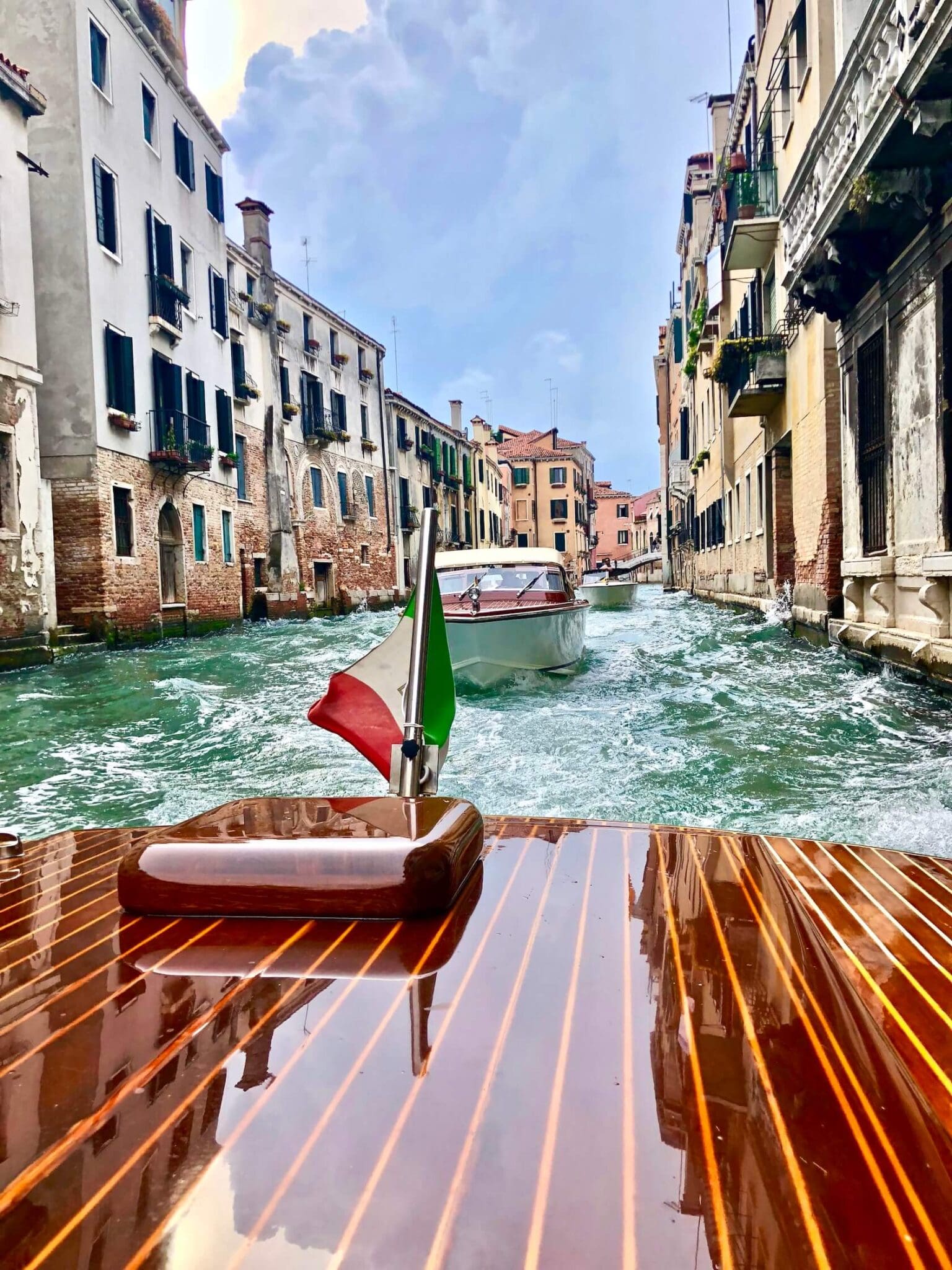
As far as physically getting to Venice, you can take the train in, or you can fly directly to the Venice Marco Polo Airport and ferry to the island.
One of the things I love most about Venice? No cars. Anywhere. It’s not that I don’t like cars, but it’s so different to be in a city where they don’t exist. The only engine hums are from the boats as they cruise the liquid paths back and forth between the canals.
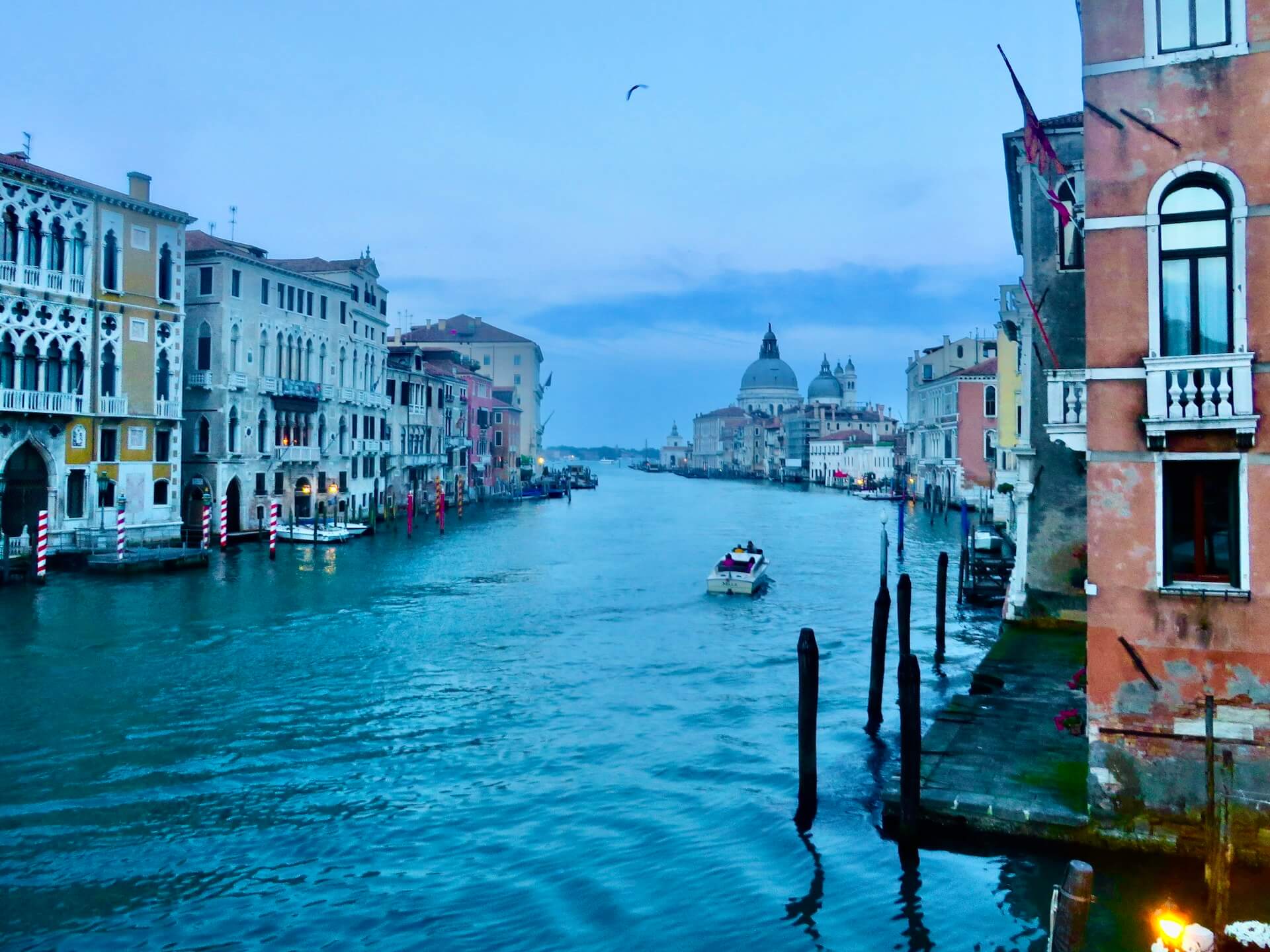
Water Taxis
While more expensive than a Vaporetto, taking a water taxi to and from your hotel is ideal especially if you have large luggage. The water taxi drivers are helpful in both loading and unloading your suitcases so you don’t make a misstep and drop them in the canal.
The hotel concierge will often help you arrange a water taxi pickup and drop-off, making the experience of booking a water taxi in advance more seamless.
*Be sure to have cash (Euros) on hand just in case credit cards are not accepted.
Gondolas
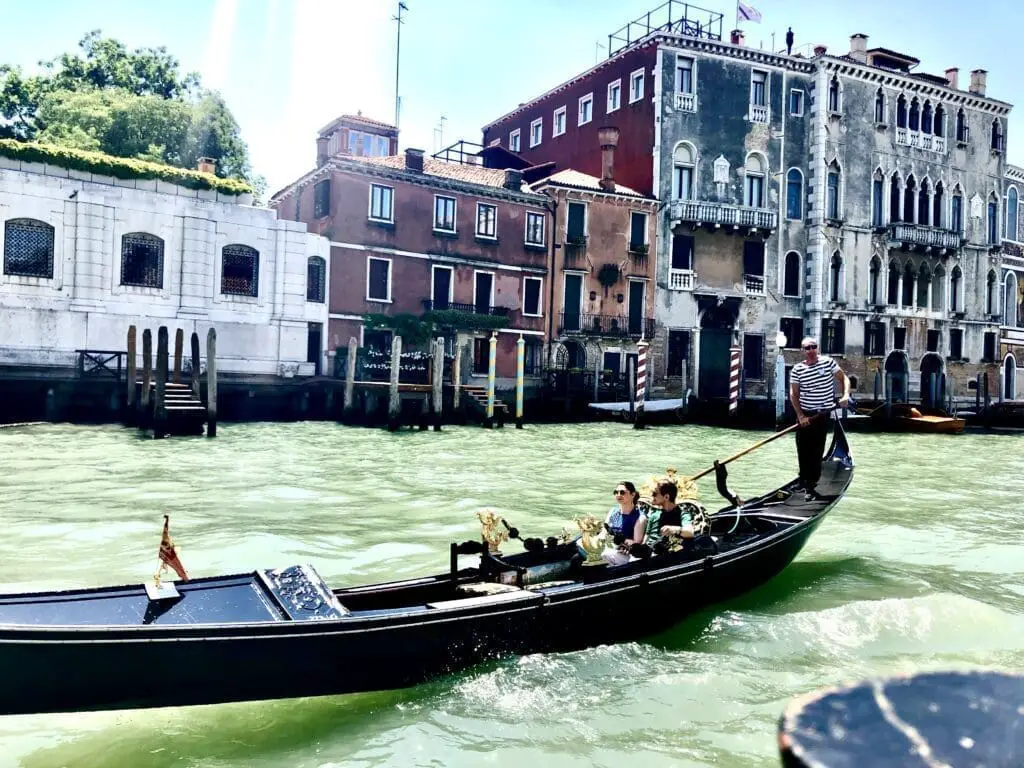
While Gondolas in Venice are a mode of transportation, they’re more about the experience than the destination.
*A note on the Gondolas: The “decked-out” ones are quite pricey. But, if you’ve always dreamed of riding in one, by all means, do it!
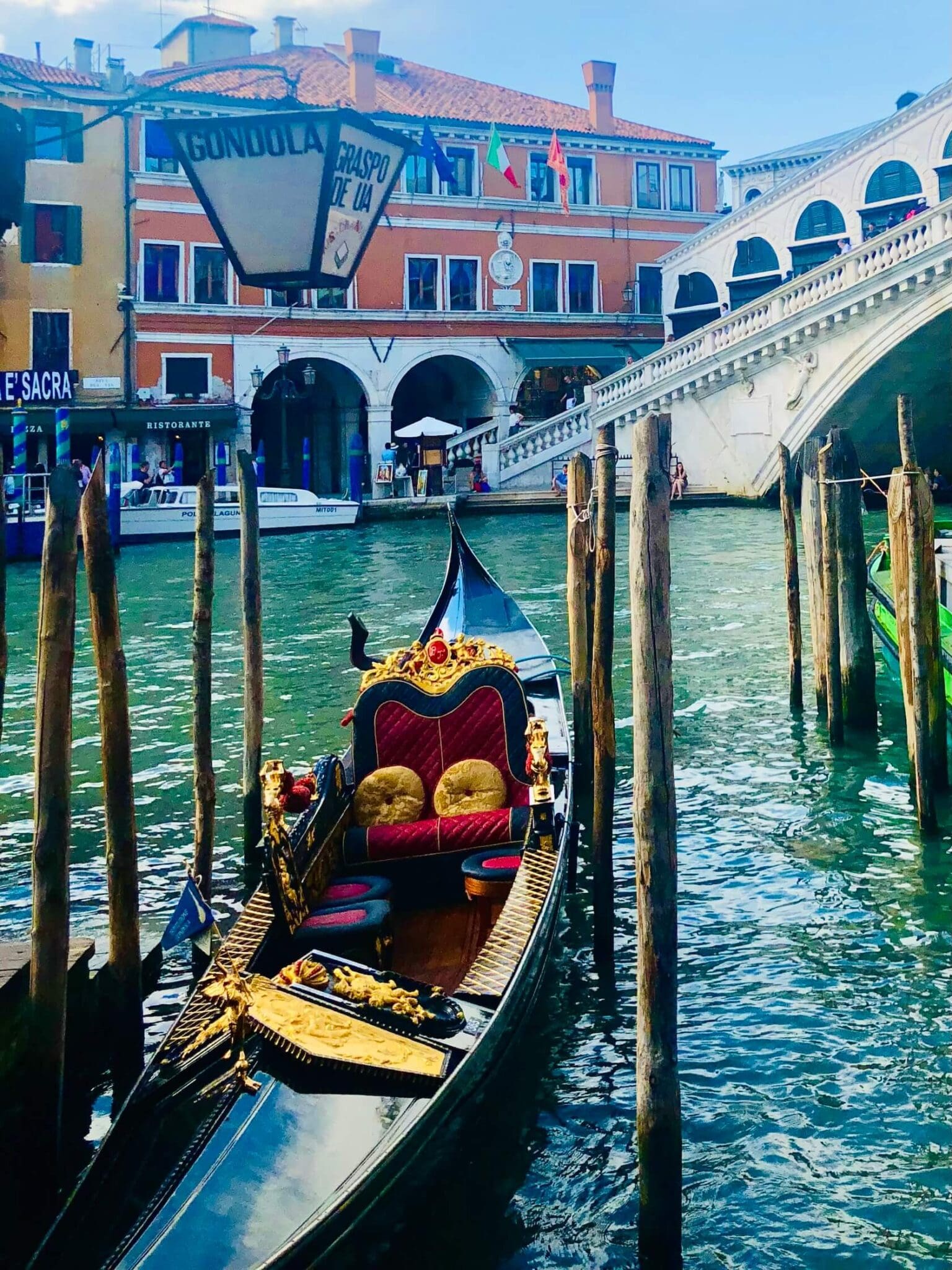
On the other hand, if you want to get from one canal to the next without all of the bells and whistles (and for a fraction of the cost), take a traghetto, which is basically a “stripped-down” version of a Gondola. You get where you want to go, but there may be a bit less singing involved.
If you want to see more of Venice Italy and get outside the tourist-centric areas, purchase a hop-on, hop-off ticket for the Vaporetto, which can take you basically anywhere you want to go.
For more information on the Venice Vaporetto and map, click here.
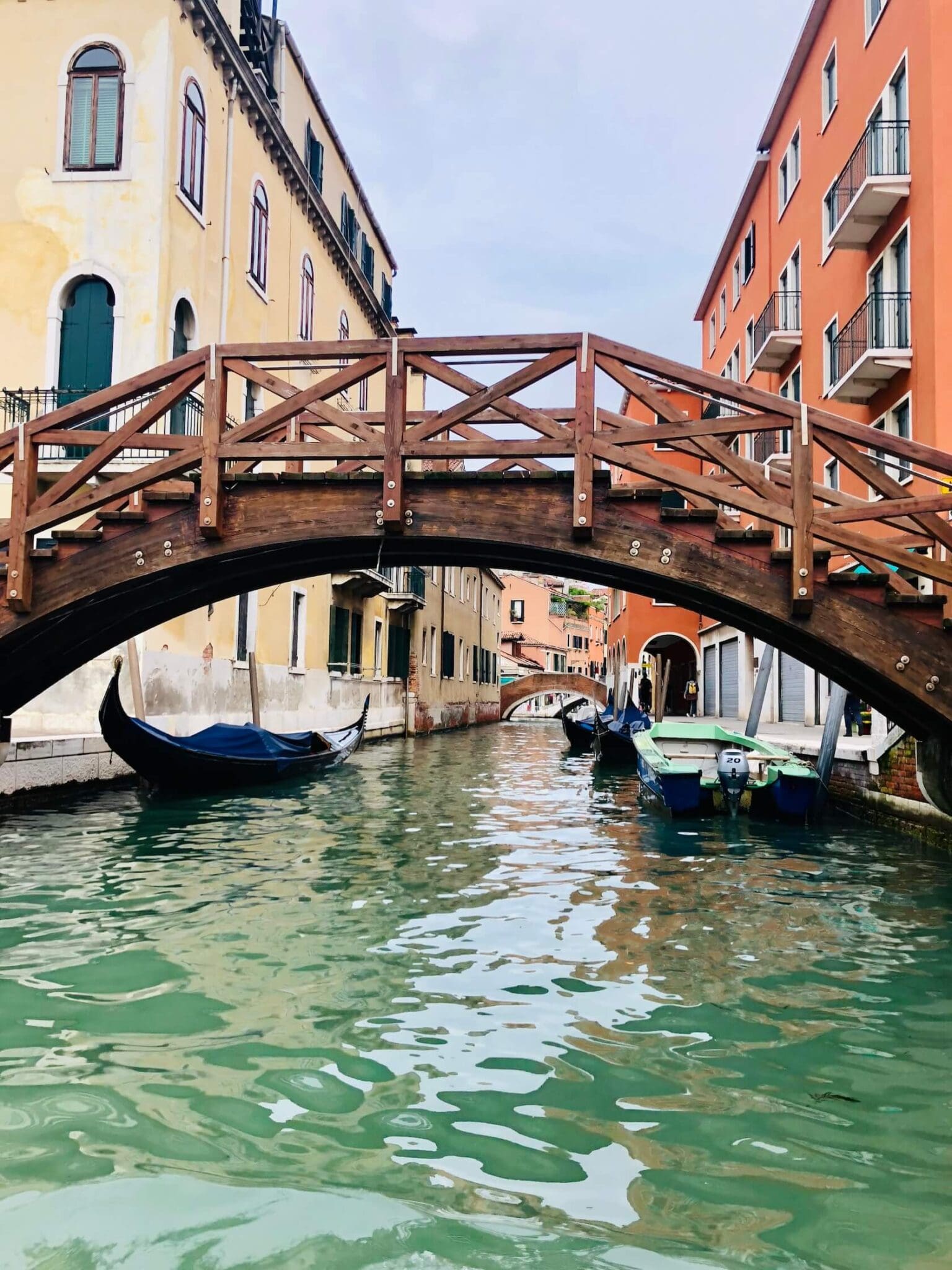
If I had the chance to choose what city to spend my evenings in, I think Venice would win out almost every time. Although, I find it hard to pinpoint why exactly. Maybe it’s because everything is just so quiet, hidden–mysterious.
I hope you enjoy your trip to Venice, Italy and if you have any tips or suggestions, feel free to drop me a comment below.
Salute!

Related Posts:
